BI-ASYMPTOTIC BILLIARD ORBITS INSIDE PERTURBEDELLIPSOIDS
- 格式:pdf
- 大小:194.43 KB
- 文档页数:15
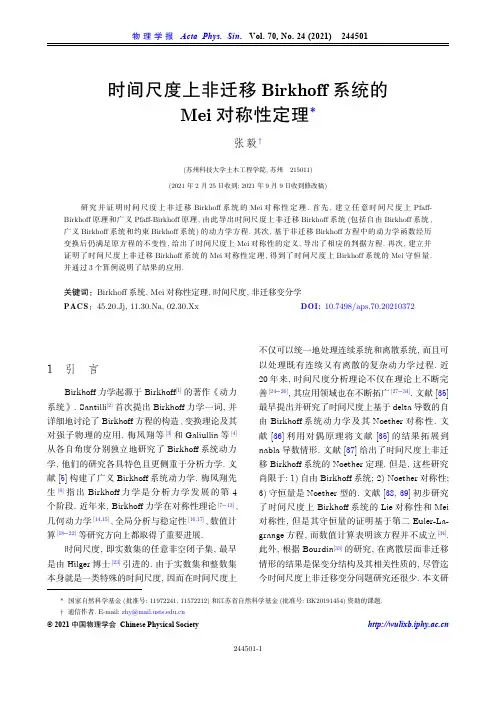
时间尺度上非迁移Birkhoff系统的Mei对称性定理*张毅†(苏州科技大学土木工程学院, 苏州 215011)(2021 年2 月25日收到; 2021 年9 月9日收到修改稿)研究并证明时间尺度上非迁移Birkhoff系统的Mei对称性定理. 首先, 建立任意时间尺度上Pfaff-Birkhoff原理和广义Pfaff-Birkhoff原理, 由此导出时间尺度上非迁移Birkhoff系统(包括自由Birkhoff系统、广义Birkhoff系统和约束Birkhoff系统)的动力学方程. 其次, 基于非迁移Birkhoff方程中的动力学函数经历变换后仍满足原方程的不变性, 给出了时间尺度上Mei对称性的定义, 导出了相应的判据方程. 再次, 建立并证明了时间尺度上非迁移Birkhoff系统的Mei对称性定理, 得到了时间尺度上Birkhoff系统的Mei守恒量.并通过3个算例说明了结果的应用.关键词:Birkhoff系统, Mei对称性定理, 时间尺度, 非迁移变分学PACS:45.20.Jj, 11.30.Na, 02.30.Xx DOI: 10.7498/aps.70.202103721 引 言Birkhoff力学起源于Birkhoff[1]的著作《动力系统》. Santilli[2]首次提出Birkhoff力学一词, 并详细地讨论了Birkhoff方程的构造、变换理论及其对强子物理的应用. 梅凤翔等[3]和Galiullin等[4]从各自角度分别独立地研究了Birkhoff系统动力学, 他们的研究各具特色且更侧重于分析力学. 文献[5]构建了广义Birkhoff系统动力学. 梅凤翔先生[6]指出Birkhoff力学是分析力学发展的第4个阶段. 近年来, Birkhoff力学在对称性理论[7−13]、几何动力学[14,15]、全局分析与稳定性[16,17]、数值计算[18−22]等研究方向上都取得了重要进展.时间尺度, 即实数集的任意非空闭子集, 最早是由Hilger博士[23]引进的. 由于实数集和整数集本身就是一类特殊的时间尺度, 因而在时间尺度上不仅可以统一地处理连续系统和离散系统, 而且可以处理既有连续又有离散的复杂动力学过程. 近20年来, 时间尺度分析理论不仅在理论上不断完善[24−26], 其应用领域也在不断拓广[27−34]. 文献[35]最早提出并研究了时间尺度上基于delta导数的自由Birkhoff系统动力学及其Noether对称性. 文献[36]利用对偶原理将文献[35]的结果拓展到nabla导数情形. 文献[37]给出了时间尺度上非迁移Birkhoff系统的Noether定理. 但是, 这些研究尚限于: 1)自由Birkhoff系统; 2) Noether对称性;3)守恒量是Noether型的. 文献[38, 39]初步研究了时间尺度上Birkhoff系统的Lie对称性和Mei 对称性, 但是其守恒量的证明基于第二Euler-La-grange方程, 而数值计算表明该方程并不成立[34].此外, 根据Bourdin[33]的研究, 在离散层面非迁移情形的结果是保变分结构及其相关性质的, 尽管迄今时间尺度上非迁移变分问题研究还很少. 本文研* 国家自然科学基金(批准号: 11972241, 11572212)和江苏省自然科学基金(批准号: BK20191454)资助的课题.† 通信作者. E-mail: zhy@© 2021 中国物理学会 Chinese Physical Society 究时间尺度上非迁移Birkhoff 系统的Mei 对称性,包括自由Birkhoff 系统、广义Birkhoff 系统和约束Birkhoff 系统, 建立并证明上述3类Birkhoff 系统的Mei 对称性定理, 给出时间尺度上新型守恒量, 称之为Mei 守恒量.2 时间尺度上非迁移Birkhoff 方程关于时间尺度上微积分及其基本性质, 读者可参阅文献[24, 25].2.1 Pfaff-Birkhoff 原理及其推广在时间尺度上, 非迁移Pfaff 作用量为R β:T ×R 2n →R B :T ×R 2n →R a ∆βa βC 1,∆rd(T )β,γ=1,2,···,2n a γσρ其中 是时间尺度上Birkhoff 函数组, 是时间尺度上Birkhoff 函数, 是Birkhoff 变量 对时间的delta 导数. 设所有函数都是 函数. .非迁移是指作用量(1)中的变量 没有经过前跳算子 或后跳算子 的作用而发生跃迁[33].等时变分原理且满足端点条件以及互易关系原理(2)称为时间尺度上非迁移Pfaff-Birkhoff 原理.等时变分原理(2)可推广为Φβ=Φβ(t,a γ)式中 表示附加项[5]. 原理(5)式可称为时间尺度上非迁移广义Pfaff-Birkhoff 原理.2.2 自由Birkhoff 系统由原理(2), 容易导出σ(t )δa ∆β其中 是前跳算子. 考虑到 的独立性,由时间尺度上Dubois-Reymond 引理[24], 得到C β其中 为常数. 因此有方程(8)为时间尺度上非迁移Birkhoff 方程.2.3 广义Birkhoff 系统由原理(5), 可导出类似于方程(8), 有方程(10)可称为时间尺度上非迁移广义Birkhoff-方程.2.4 约束Birkhoff 系统约束方程为将(11)式取变分, 得由(6)式和(12)式, 容易导出λj =λj (t,a β)λj 其中 为约束乘子. 假设约束(11)式相互独立, 则由(11)式和(13)式可解出 . 于是方程(13)可写成P β=λj∂f j∂a β其中 . 方程(14)可视作与约束Birk-hoff 系统(13)和(11)相应的自由Birkhoff 系统.只要初始条件满足约束方程(11), 那么方程(14)的解就给出约束Birkhoff 系统的运动.3 Mei 对称性3.1 自由Birkhoff 系统引进无限小变换t →ϑ(t )=t +υξ0+o (υ)C 1,∆rd υ∈R ϑ(t )¯T¯σ¯∆其中映射 是1个严格递增 函数, 是无限小参数, 是一个新的时间尺度 , 前跳算子为 , delta 导数为 .B R β¯B ¯Rβ在变换(15)下, 动力学函数 和 变换为 和 , 有υ=0将(16)式在 处Taylor 级数展开, 得到Y (0)=ξ0∂/∂t +ξβ∂/∂a β其中 .定义1 对于时间尺度上非迁移Birkhoff 系统(8), 如果成立, 则变换(15)称为Mei 对称性的.判据1 如果变换(15)满足如下判据方程:则变换相应于时间尺度上非迁移Birkhoff 系统(8)的Mei 对称性.3.2 广义Birkhoff 系统B R βΦβ¯B¯R β¯Φβ设时间尺度上动力学函数 , 和 经历变换(15)后, 成为 , 和 , 有于是有下述定义2和判据2.定义2 对于时间尺度上非迁移广义Birkhoff 系统(10), 如果成立, 则变换(15)称为Mei 对称性的.判据2 如果变换(15)满足如下判据方程:则变换相应于时间尺度上非迁移广义Birkhoff 系统(10)的Mei 对称性.3.3 约束Birkhoff 系统B R βP βf j ¯B ¯R β¯P β¯f j 设时间尺度上动力学函数 , 和 , 以及约束 经历变换(15)后, 成为 , , 和 , 有于是有下述定义3和判据3.定义3 对于时间尺度上与约束Birkhoff 系统(13)和(11)相应的自由Birkhoff 系统(14), 如果成立, 则变换(15)称为Mei 对称性的.判据3 如果变换(15)满足如下判据方程:则变换相应于时间尺度上相应自由Birkhoff 系统(14)的Mei 对称性.定义4 对于时间尺度上约束Birkhoff 系统(13)和(11), 如果方程(24)以及如下方程成立, 则变换(15)称为Mei 对称性的.判据4 如果变换(15)满足判据方程(25)和如下限制方程:则变换相应于时间尺度上约束Birkhoff 系统(13)和(11)的Mei 对称性.4 Mei 对称性定理4.1 自由Birkhoff 系统定理1 假设变换(15)满足判据方程(19), 则时间尺度上非迁移Birkhoff 系统(8)存在新型守恒量G M 其中 是规范函数, 满足因此, (28)式是系统的守恒量. 证毕.定理1可称为时间尺度上非迁移Birkhoff 系统(8)的Mei 对称性定理, (28)式称为Mei 守恒量.4.2 广义Birkhoff 系统定理2 假设变换(15)满足判据方程(22), 则时间尺度上非迁移广义Birkhoff 系统(10)存在新型守恒量G M 其中 是规范函数, 满足证明∇∇tI M =0将方程(22)和方程(33)代入(34)式, 得到, 于是(32)式是系统的守恒量.定理2可称为时间尺度上非迁移广义Birkhoff 系统(10)的Mei 对称性定理, (32)式称为Mei 守恒量. 证毕.4.3 约束Birkhoff 系统定理3 假设变换(15)满足判据方程(25), 则时间尺度上与约束Birkhoff 系统(13)和(11)相应的自由Birkhoff 系统(14)存在新型守恒量G M 其中 是规范函数, 满足G M 定理4 假设变换(15)满足判据方程(25)和限制条件(27)式, 则时间尺度上约束Birkhoff 系统(13)和(11)存在新型守恒量(35), 其中规范函数 满足方程(36).定理3为时间尺度上与约束Birkhoff 系统(13)和(11)相应的自由Birkhoff 系统(14)的Mei 对称性定理.定理4为时间尺度上非迁移约束Birkhoff 系统的Mei 对称性定理, (35)式是Mei 守恒量.5 算 例例1 研究时间尺度上Birkhoff 系统, 设Birk -hoff 函数和Birkhoff 函数组为试研究该系统的Mei 对称性与守恒量.由方程(8)得到T =R 如取 , 则方程(38)成为这是著名的Hojman-Urrutia 问题[3,4]. 该问题本质上不是自伴随的, 因此没有Lagrange 结构或Hami-lton 结构.下面来计算Mei 对称性. 经计算, 有取生成函数为则生成函数(41)满足判据方程(19), 因此它相应于系统的Mei 对称性. 将(41)式代入方程(29), 可解得由定理1, 系统有Mei 守恒量, 形如(44)式表明, 对于任意的时间尺度, (44)式都是Birkhoff 系统(37)的守恒量. 如取生成函数为那么生成函数(45)也是Mei 对称的, 由方程(29)得由定理1, 得到Mei 守恒量T =R σ(t )=t 对于守恒量(47), 如果系统是通常的Birkhoff 系统, 即取 , 则 , 从而(47)式给出T =h Z h>0σ(t )=t +h 这是通常意义下Hojman-Urrutia 问题的守恒量[3].如果是离散情形, 即取 , 这里 , 则 , 从而(47)式成为h 这是步长为 的离散版本的Mei 守恒量.例2 研究时间尺度上广义Birkhoff 系统的Mei 对称性与守恒量.广义Birkhoff 方程(10)给出计算Mei 对称性, 由于将(52)式代入判据方程(22), 有解(53)式和(54)式相应于系统的Mei 对称性. 将(53)式代入方程(33), 解得由定理2, 系统有Mei 守恒量, 形如G M =−2t 同理, 相应于生成函数(54), , 由定理2得(56)式和(57)式是由Mei 对称性(53)和(54)导致的Mei 守恒量.例3 研究时间尺度上约束Birkhoff 系统约束为g φ试研究其Mei 对称性与守恒量,其中 和 是常数.方程(13)给出由方程(59)和方程(60),解得因此有做计算取生成函数为则µ(t )=σ(t )−t ν(t )=t −ρ(t )其中 为向前互差函数, 为向后互差函数. 由判据4, 生成函数(64)相应于系统的Mei 对称性. 将(65)式代入方程(36),解得由定理4, 系统有Mei 守恒量, 形如6 讨 论T =R σ(t )=t µ(t )=0如果取时间尺度 , 则前跳算子 ,互差函数 , 因此上述结果退化为通常意义下Birkhoff 系统、广义Birkhoff 系统和约束Birkh-off 系统连续版本的变分原理、Birkhoff 方程和Mei 对称性定理.T =R 例如, 对于自由Birkhoff 系统, 当取 时,原理(2)成为方程(8)成为由判据方程(19)容易得到于是, 定理1退化为下述推论1.推论1 假设变换(15)满足判据方程(19),则自由Birkhoff 系统(69)的Mei 对称性导致如下G M 其中 是规范函数, 满足推论1是通常意义下自由Birkhoff 系统连续版本的Mei 对称性与守恒量定理[7]. 而方程(68)、方程(69)和方程(71)就是通常意义下自由Birk-hoff 系统连续版本的Pfaff-Birkhoff 原理、Birk-hoff 方程和Mei 守恒量.T =h Z h >0σ(t )=t +h µ(t )=h 如果取时间尺度 , 常数 , 则前跳算子 , 互差函数 . 此时, 原理(2)成为方程(8)成为则定理1退化为下述推论2.推论2 假设变换(15)满足判据方程(19), 则自由Birkhoff 系统(74)的Mei 对称性导致如下形式的守恒量:G M 其中 是规范函数, 满足h 推论2是通常意义下自由Birkhoff 系统离散版本的Mei 对称性与守恒量定理. 而方程(73)—(75)就是通常意义下自由Birkhoff 系统离散版本步长为 的Pfaff-Birkhoff 原理、Birkhoff 方程和Mei 守恒量.7 结 论对称性和守恒量一直是分析力学研究的一个重要方面. 经典的对称性主要有Noether 对称性和Lie对称性. Mei对称性是本质上不同于前两种对称性的一种不变性, 它可以导致Mei守恒量. Mei守恒量不同于Noether守恒量, 是一种新的守恒量. 本文提出并研究了时间尺度上非迁移Birkhoff系统的Mei对称性定理.一是提出了时间尺度上非迁移Pfaff-Birkhoff 原理和广义Pfaff-Birkhoff原理, 导出了时间尺度上Birkhoff系统, 包括自由Birkhoff系统、广义Birkhoff系统和约束Birkhoff系统的动力学方程.主要结果是原理(2)和(5), Birkhoff方程(8), (10)和(13).二是定义了时间尺度上非迁移Birkhoff系统的Mei对称性, 并导出了它的判据方程. 主要结果是4个定义和4个判据.三是提出并证明了时间尺度上非迁移Birkhoff 系统、非迁移广义Birkhoff系统和非迁移约束Birkhoff系统的Mei对称性定理. 主要结果是4个定理, Mei守恒量(28), (32)和(35).T=R T=h Z当取时间尺度和时, 文中定理给出通常意义下自由Birkhoff系统、广义Birkhoff 系统和约束Birkhoff系统的连续版本和离散版本的Mei对称性与守恒量定理. 由于除了实数集和整数集以外, 时间尺度还可以有很多选择, 因此时间尺度上Birkhoff系统的Mei对称性定理具有一般性.参考文献B irkhoff G D 1927 Dynamical Systems (Providence: AMSCollege Publ. ) pp59–96[1]S antilli R M 1983 Foundations of Theoretical Mechani cs II (New York: Springer-Verlag) pp1–280[2]M ei F X, Shi R C, Zhang Y F, Wu H B 1996 Dynamics of Birkhoffian System (Beijing: Beijing Institute of Technology Press) pp1–228[3]G aliullin A S, Gafarov G G, Malaishka R P, Khwan A M1997 Analytical Dynamics of Helmholtz, Birkhoff and Nambu Systems (Moscow: UFN) pp118–226[4]M ei F X 2013 Dynamics of Generalized Birkhoffian Systems (Beijing: Science Press) pp1–206[5]M ei F X, Wu H B, Li Y M, Chen X W 2016 J. Theor. Appl.Mech. 48 263 (in Chinese) [梅凤翔, 吴惠彬, 李彦敏, 陈向炜2016 力学学报 48 263][6]M ei F X 2004 Symmetries and Conserved Quantities of [7]Constrained Mechanical Systems (Beijing: Beijing Institute of Technology Press) pp1–482 (in Chinese) [梅凤翔 2004 约束力学系统的对称性与守恒量 (北京: 北京理工大学出版社) 第1—482页]W ang P, Xue Y, Liu Y L 2012 Chin. Phys. B 21 070203 [8]Z hang Y, Zhai X H 2015 Nonlinear Dyn. 81 469[9]Z hang H B, Chen H B 2017 J. Math. Anal. Appl. 456 1442 [10]Z hang Y 2018 Int. J. Non-Linear Mech. 101 36[11]X u X X, Zhang Y 2020 Acta Phys. Sin. 69 220401 (in Chinese) [徐鑫鑫, 张毅 2020 物理学报 69 220401][12]Z hang L J, Zhang Y 2020 Commun. Nonlinear Sci. Numer.Simul. 91 105435[13]G uo Y X, Liu C, Liu S X 2010 Commun. Math. 18 21[14]L iu S X, Liu C, Guo Y X 2011 Chin. Phys. B 20 034501[15]C hen X W, Li Y M 2013 Acta Mech. 224 1593[16]L uo S K, He J M, Xu Y L 2016 Int. J. Non-Linear Mech. 78 105[17]L iu S X, Liu C, Guo Y X 2011 Acta Phys. Sin. 60 064501 (in Chinese) [刘世兴, 刘畅, 郭永新 2011 物理学报 60 064501] [18]L iu S X, Liu C, Hua W, Guo Y X 2016 Chin. Phys. B 25 114501[19]K ong X L, Wu H B, Mei F X 2013 Appl. Math. Comput. 225 326[20]K ong X L, Wu H B 2017 Acta Phys. Sin. 66 084501 (in Chinese) [孔新雷, 吴惠彬 2017 物理学报 66 084501][21]H e L, Wu H B, Mei F X 2017 Nonlinear Dyn. 87 2325[22]H ilger S 1990 Results Math. 18 18[23]B ohner M, Peterson A 2001 Dynamic Equations on TimeScales (Boston: Birkhäuser) pp1–353[24]B ohner M, Georgiev S G 2016 Multivariable DynamicCalculus on Time Scales (Switzerland: Springer International Publishing AG) pp1–600[25]G eorgiev S G 2018 Fractional Dynamic Calculus andFractional Dynamic Equations on Time Scales (Switzerland: Springer International Publishing AG) pp1–357[26]A tici F M, Biles D C, Lebedinsky A 2006 Math. Comput.Modell. 43 718[27]B ohner M 2004 Dyn. Syst. Appl. 13 339[28]B artosiewicz Z, Torres D F M 2008 J. Math. Anal. Appl. 3421220[29]B enkhettou N, Brito da Cruz A M C, Torres D F M 2015Signal Process. 107 230[30]D ryl M, Torres D F M 2017 Springer Proceedings inMathematics & Statistics 195 223[31]H an Z L, Sun S R 2014 Oscillation Theory of DynamicEquations on Time Scales (Jinan: Shandong University Press) pp1–232 (in Chinese) [韩振来, 孙书荣 2014 时间尺度上动态方程振动理论 (济南: 山东大学出版社) 第1—232页][32]B ourdin L 2014 J. Math. Anal. Appl. 411 543[33]A nerot B, Cresson J, Belgacem K H, Pierret F 2020 J. Math.Phys. 61 113502[34]S ong C J, Zhang Y 2015 J. Math. Phys. 56 102701[35]S ong C J, Zhang Y 2017 J. Nonlinear Sci. Appl. 10 2268 [36]S ong C J, Cheng Y 2020 Appl. Math. Comput. 374 125086 [37]Z hang Y 2019 Chaos, Solitons Fractals 128 306[38]Z hang Y, Zhai X H 2019 Commun. Nonlinear Sci. Numer.Simul. 75 251[39]Mei’s symmetry theorems for non-migrated Birkhoffiansystems on a time scale*Zhang Yi †(College of Civil Engineering, Suzhou University of Science and Technology, Suzhou 215011, China)( Received 25 February 2021; revised manuscript received 9 September 2021 )AbstractThe Mei symmetry and its corresponding conserved quantities for non-migrated Birkhoffian systems on a time scale are proposed and studied. Firstly, the dynamic equations of non-migrated Birkhoffian systems (including free Birkhoffian systems, generalized Birkhoffian systems and constrained Birkhoffian systems) on a time scale are derived based on the time-scale Pfaff-Birkhoff principle and time-scale generalized Birkhoff principle. Secondly, based on the fact that the dynamical functions in the non-migrated Birkhoff’s equations still satisfy the original equations after they have been transformed, the definitions of Mei symmetry on an arbitrary time scale are given, and the corresponding criterion equations are derived. Thirdly, Mei’s symmetry theorems for non-migrated Birkhoffian systems on a time scales are established and proved, and Mei conserved quantities of Birkhoffian systems on a time scale are obtained. The results are illustrated by three examples.Keywords: Birkhoffian system, Mei’s symmetry theorem, time scale, non-migrated variational calculus PACS: 45.20.Jj, 11.30.Na, 02.30.Xx DOI: 10.7498/aps.70.20210372* Project supported by the National Natural Science Foundation of China (Grant Nos. 11972241, 11572212) and the Natural Science Foundation of Jiangsu Province, China (Grant No. BK20191454).† Corresponding author. E-mail: zhy@。
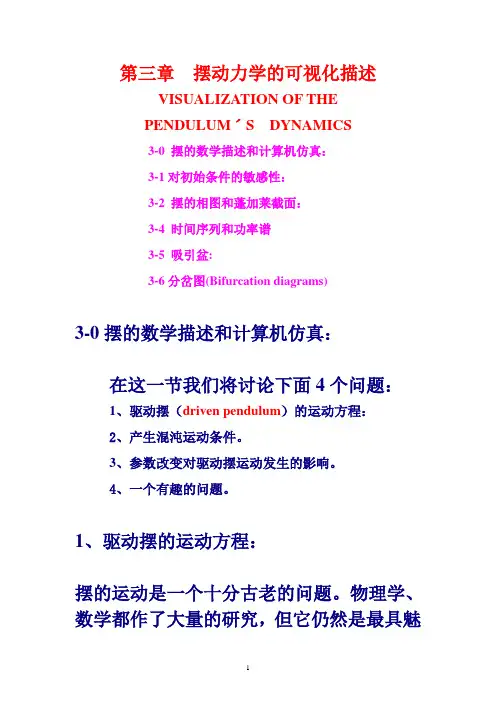
第三章摆动力学的可视化描述VISUALIZATION OF THEPENDULUMˊS DYNAMICS3-0 摆的数学描述和计算机仿真:3-1对初始条件的敏感性:3-2 摆的相图和蓬加莱截面:3-4 时间序列和功率谱3-5 吸引盆:3-6分岔图(Bifurcation diagrams)3-0摆的数学描述和计算机仿真:在这一节我们将讨论下面4个问题:1、驱动摆(driven pendulum)的运动方程:2、产生混沌运动条件。
3、参数改变对驱动摆运动发生的影响。
4、一个有趣的问题。
1、驱动摆的运动方程:摆的运动是一个十分古老的问题。
物理学、数学都作了大量的研究,但它仍然是最具魅力的研究课题。
首先我们写出驱动摆(driven pendulum ,也叫做“强迫振动摆”)的运动方程://sin cos d dt q g ωωθφ=--+/d dt θω= (3-1) /D d dt φω=方程组(3-1)中有3个状态变量:θ—摆的角位移(angular displacement ); ω—摆的角速度(angular velocity ); φ—驱动力的相位角(drive phase angle )。
因此它的轨线在3维相空间描绘。
方程(3-1)中也有3个参数:q —阻尼系数(damping factor );g —驱动力幅值(driving force amplitude ); D ω—驱动力角频率(angular drivefrequency)。
同时考虑3个参数来研究驱动摆的性态,也就是说,在3维相空间和3维参数空间内考察摆的形态,将是一个十分困难、实际上不可能完成的任务。
我们把ωD固定,选择少数几个q值,让g 值在一定的区间充分变化,以观察系统的性态。
(在Appendix B(Page 207, Listing 4)中有描述摆运动的计算机程序(Title: Motion),可供参考。
)2、产生混沌运动的条件:产生混沌的必要条件有2条(See: Page 2):(1)系统至少要有3个独立的动力学变量;(2)系统至少要有1项包含了几个动力学变量的非线性项。
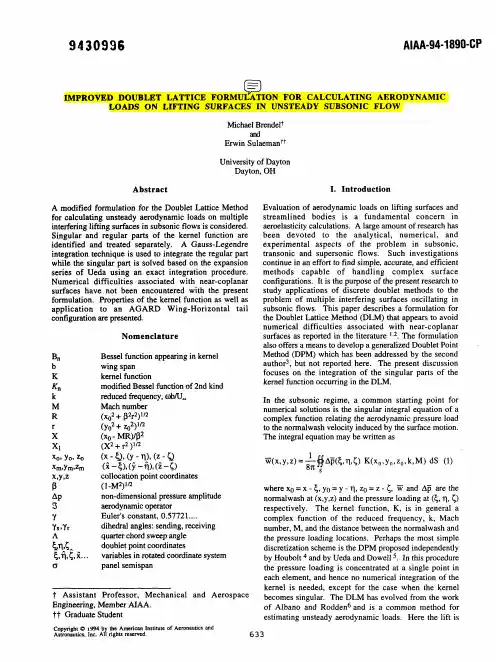
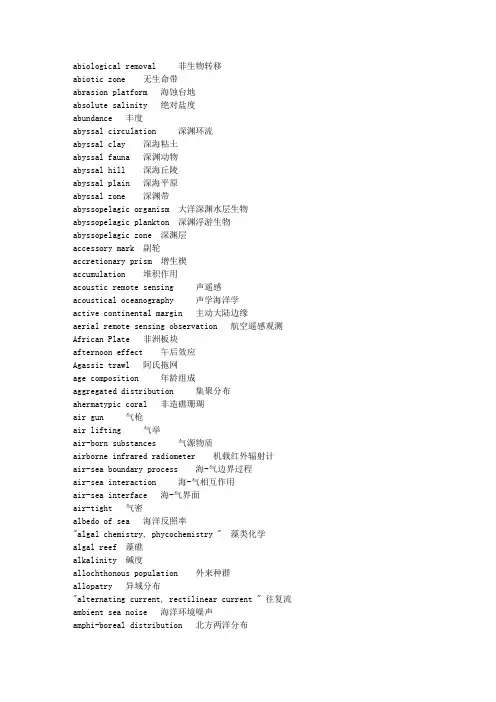
abiological removal 非生物转移abiotic zone 无生命带abrasion platform 海蚀台地absolute salinity 绝对盐度abundance 丰度abyssal circulation 深渊环流abyssal clay 深海粘土abyssal fauna 深渊动物abyssal hill 深海丘陵abyssal plain 深海平原abyssal zone 深渊带abyssopelagic organism 大洋深渊水层生物abyssopelagic plankton 深渊浮游生物abyssopelagic zone 深渊层accessory mark 副轮accretionary prism 增生楔accumulation 堆积作用acoustic remote sensing 声遥感acoustical oceanography 声学海洋学active continental margin 主动大陆边缘aerial remote sensing observation 航空遥感观测African Plate 非洲板块afternoon effect 午后效应Agassiz trawl 阿氏拖网age composition 年龄组成aggregated distribution 集聚分布ahermatypic coral 非造礁珊瑚air gun 气枪air lifting 气举air-born substances 气源物质airborne infrared radiometer 机载红外辐射计air-sea boundary process 海-气边界过程air-sea interaction 海-气相互作用air-sea interface 海-气界面air-tight 气密albedo of sea 海洋反照率"algal chemistry, phycochemistry " 藻类化学algal reef 藻礁alkalinity 碱度allochthonous population 外来种群allopatry 异域分布"alternating current, rectilinear current " 往复流ambient sea noise 海洋环境噪声amphi-boreal distribution 北方两洋分布amphidromic point 无潮点"amphidromic system, amphidrome " 旋转潮波系统amphi-Pacific distribution 太平洋两岸分布anadromic fish 溯河鱼anaerobic zone 厌氧带anaerobiosis 厌氧生活analytical chemistry of sea water 海水分析化学"anchor ice, ground ice " 锚冰anchorage area 锚泊地anchored structure 锚泊结构anomalous sea level 异常水位anoxic basin 缺氧海盆anoxic event 缺氧事件anoxic water 缺氧水"Antarctic Bottom Water, AABW " 南极底层水Antarctic Circumpolar Current 南极绕极流Antarctic Circumpolar Water Mass 南极绕极水团Antarctic Plate 南极洲板块anthropogenic hydrocarbon 人源烃anthropogenic input 人源输入antifouling 防污着aphotic zone 无光带"apparent oxygen utilization, AOU " 表观耗氧量aquaculture 水产养殖aquaculture 水产栽培aquafarm 水产养殖场aquanaut work 潜水作业aquaranch 水中牧场aquatic community 水生群落aquatic ecosystem 水生生态系archipelago 群岛Arctic Ocean 北冰洋"Arctic Water, North Polar Water " 北极水arc-trench-basin system 沟弧盆系armor block 护面块体armored diving 铠装潜水artificial island 人工岛artificial sea water 人工海水aseismic ridge 无震海岭assemblage 组合assimilation efficiency 同化效率assimilation number 同化数association 群聚astronomical tide 天文潮"Atlantic Equatorial Undercurrent, Lomonosov Current " 大西洋赤道潜流Atlantic Ocean 大西洋Atlantic-type coastline 大西洋型岸线Atlantic-type continental margin 大西洋型大陆边缘atmospheric input 大气输入atmospheric sea salt 大气海盐atmospheric transport 大气输送atoll 环礁auricularia larva 耳状幼体Australia-Antarctic Rise 澳大利亚-南极海隆autecology 个体生态学authigenic sediment 自生沉积autoinhibitory substance 自体抑制物质autotroph 自养生物auxotroph 营养缺陷生物average heavy swell 中狂涌average height of the heighest one-tenth wave 1/10 [大波平均]波高average height of the heighest one-third wave 1/3 [大波平均]波高average moderate swell 中中涌axially symmetric marine gravimeter 轴对称式海洋重力仪azimuth correction 方位改正back-arc 弧后back-arc basin 弧后盆地back-arc spreading 弧后扩张backshore 后滨bacterial film 细菌膜bacterial slime 细菌粘膜bacterioneuston 漂游细菌barbor boat 港作船baroclinic ocean 斜压海洋barophilic bacteria 喜压细菌barotropic ocean 正压海洋barrier 沙坝barrier island 沙坝岛barrier reef 堡礁baseline study 基线研究batch culture 一次性培养bathyal fauna 深海动物bathyal zone 深海带bathymetry 水深测量bathypelagic organism 大洋深层生物bathypelagic plankton 深层浮游生物bathypelagic zone 深层beach 海滩beach berm 滩肩beach cusp 滩角beach cycle 海滩旋回beach face 滩面beach nourishment 人工育滩beach profile 海滩剖面beach ridge 滩脊beach rock 海滩岩beam trawl 桁拖网bench 岩滩Benioff zone 贝尼奥夫带benthic community 底栖生物群落benthic division 海底区benthic-pelagic coupling 海底-水层耦合benthology 底栖生物学benthos 底栖生物berth 泊位bioadhesion 生物粘着bioassay 生物测试"biochemical oxygen demand, BOD " 生化需氧量biodegradation 生物降解biodeterioration 生物污染bioerosion 生物侵蚀biofacy 生物相biofouling 生物污着biogenic sediment 生物沉积biogenous hydrocarbon 生源烃biogenous silica 生源硅石biological detritus 生物碎屑biological input 生物输入biological noise 生物噪声biological oceanography 生物海洋学biological purification 生物净化biological removal 生物转移biological scavenging 生物清除bioluminescence 生物发光biomass 生物量bionics 仿生学biosphere 生物圈biota 生物区系biotope 生活小区bioturbation 生物扰动biozone 生物带bipinnaria larva 羽腕幼体bipolarity 两极同源bird-foot delta 鸟足[形]三角洲Bohai Coastal Current 渤海沿岸流Bohai Sea 渤海boomerang sediment corer 自返式沉积物取芯器borate alkalinity 硼酸[盐]碱度"borer, boring organism " 钻孔生物bottom current 底层流bottom friction layer 底摩擦层bottom grab 表层取样器bottom reflection 海底声反射bottom reverberation 海底混响bottom scattering 海底散射bottom water 底层水bottom wave 底波bottom-supported platform 坐底式平台boundary flux 界面通量box corer 箱式取样器box model 箱式模型brackish water species 半咸水种brash ice 碎冰"breaker, surf " 碎波breakwater 防波堤brine 卤水"brown clay, red clay " 褐粘土bubble effect 气泡效应buoyant mat 浮力沉垫burrowing organism 穴居生物caballing [混合]增密caisson 沉箱calcareous ooze 钙质软泥"calcite compensation depth, CCD " 方解石补偿深度calcite dissolution index 方解石溶解指数calm sea 无浪capillary wave 毛细波carbon assimilation 碳同化作用carbon cycle 碳循环carbon dioxide system in sea water 海水二氧化碳系统carbonate alkalinity 碳酸[盐]碱度"carbonate critical depth, CCRD " 碳酸盐极限深度carbonate cycle 碳酸盐旋回carbonate system in sea water 海水碳酸盐系统carcinology 甲壳动物学carnivore 食肉动物catastrophe 灾变catch 渔获量catchability coefficient 可捕系数cathodic protection 阴极防护cellar connection 井口装置Central Indian Ridge 印度洋中脊central rift 中央裂谷central water 中央水chain of volcanoes 火山链"Changjiang Diluted Water, Changjiang River Plume " 长江冲淡水characteristic species 特征种chemical diagenesis 化学成岩作用chemical form 化学形态chemical oceanography 化学海洋学"chemical oxygen demand, COD " 化学需氧量chemical scavenging 化学清除chemical speciation 化学形态分析chemical speciation models 化学形态模型chemical species 化学形式chemical weathering 化学风化作用chemo-autotroph 化能自养生物chemostatic culture 恒化培养"chemotaxis, chemotaxy " 趋化性chemotrophy 化能营养"China Classification Society, ZC " 中国船级社chlorinity 氯度chlorinity ratio 氯度比值chlorosity 氯量chronostratigraphy 年代地层学ciguatoxic fish 西加毒鱼类circumpacific volcanic belt 环太平洋火山带clay 粘土"closed season, prohibited season " 禁渔期cnoidal wave 椭圆余弦波coast of emergence 上升海岸coast of submergence 下沉海岸"coastal current, littoral current " 沿岸流coastal dune 海岸沙丘coastal engineering 海岸工程coastal terrace 海岸阶地coastal water 沿岸水coastal zone 海岸带coastline 海岸线coastline effect 海岸效应coccolith ooze 颗石软泥cofferdam 围堰cold current 寒流cold eddy 冷涡cold water species 冷水种cold water sphere 冷水圈cold water tongue 冷水舌collision zone 碰撞带commensalism 共栖commensalism 偏利共生common species 习见种community 群落community ecology 群落生态学compensation current 补偿流compensation depth 补偿深度compliant structure 顺应式结构composite breakwater 混合式防波堤compound shoreline 复合滨线compound tide 复合潮conchology 贝类学"conductivity-temperature-depth system, CTD " 温盐深仪confused sea 暴涛confused swell 暴涌conservative constituents of sea water 海水保守成分constancy of composition of sea water 海水成分恒定性constituent day 分潮日constituent hour 分潮时constructive boundary 建设性板块边界consumer 消费者continental accretion 大陆增生continental drift 大陆漂移continental margin 大陆边缘continental rise 大陆隆continental shelf 大陆架continental shelf break 大陆架坡折continental slope 大陆坡continental terrace 大陆阶地"continuous cultivation, continuous culture " 连续培养continuous model 连续模型contour current 等深流contourite 等深流沉积[岩]contrast in water 水中对比度contrast transmission in water 水中对比度传输controlled ecosystem experiment 控制生态系实验convective mixing 对流混合conventional diving 常规潜水convergent boundary 会聚边界conversion efficiency 转换效率"copepodite, copepodid larva " 桡足幼体coprophagy 食粪动物coral reef 珊瑚礁coral reef coast 珊湖礁海岸corrosion in sea water 海水腐蚀cosmogenous sediment 宇宙沉积cosmopolitan 世界[广布]种cotidal chart 同潮图countercurrent 逆流crane barge 起重船critical depth 临界深度crop 收获cross-coupling effect 交叉耦合效应current meter 海流计current pattern 流型cuspate bar 尖角坝cuspate delta 尖[形]三角洲cyphonautes larva 苔藓虫幼体cypris larva 腺介幼体Dalmatian coastline 达尔马提亚岸线datum of chart 海图基准面day-night observation 连续观测deck unit 甲板装置deep current 深层流"deep scattering layer, DSL " 深海散射层deep sea fan 深海扇deep sea propagation 深海传播deep sea sand 深海砂deep sea sediment 深海沉积deep sea sound channel 深海声道deep water 深层水deep water wave 深水波delta 三角洲demersal fish 底层鱼类density current 密度流density current 异重流density-dependent mortality 密度制约死亡率deposit feeder 食底泥动物descriptive oceanography 描述海洋学destructive boundary 破坏性板块边界detached breakwater 岛式防波堤detached wharf 岛式码头detritus feeder 食碎屑动物diagonal wave 斜向浪diatom ooze 硅藻软泥"dicycle, dicycly " 双周期"diel vertical migration, diurnal vertical migration " 昼夜垂直移动dilution cycle 稀释旋回directional wave spectrum 方向波谱dissolution cycle 溶解旋回"dissolved inorganic carbon, DIC " 溶解无机碳"dissolved organic carbon, DOC " 溶解有机碳"dissolved organic matter, DOM " 溶解有机物"dissolved organic nitrogen, DON " 溶解有机氮"dissolved organic phosphorus, DOP " 溶解有机磷dissolved oxygen 溶解氧disturbing acceleration 干扰加速度diurnal inequality 日不等[现象]diurnal tide 全日潮diver 潜水员divergent boundary 离散边界diversity 多样性diving suit 潜水服dock 船坞dominant species 优势种"Donghai Coastal Current, East China Sea Coastal Current " 东海沿岸流"Donghai Sea, East China Sea " 东海Doppler current meter 多普勒海流计double diffusion 双扩散double ebb 双低潮double flood 双高潮downwelling 下降流dredge 底栖生物刮底网dredger 挖泥船dredging engineering 疏浚工程drift current 漂流drift ice 流冰drifting buoy 漂流浮标drill conductor 隔水套管drilling vessel 钻探船dry diving 干式潜水duration-limited spectrum 有限风时谱dynamic method 动力方法dynamic positioning 动力定位dynamical oceanography 动力海洋学East African Rift Zone 东非裂谷带East Pacific Rise 东太平洋海隆"ebb, ebb tide " 落潮echinopluteus larva 海胆幼体echo ranging 回声测距echosounder 测深仪ecological barrier 生态障碍ecosystem 生态系edge wave 边缘波efflux 输出通量Ekman depth 埃克曼深度Ekman layer 埃克曼层Ekman pumping 埃克曼抽吸Ekman spiral 埃克曼螺旋Ekman transport 埃克曼输送El Nino ( 西) 厄尔尼诺electrodialysis 电渗析electromagnetic vibration exciter 电磁振荡震源elliptical trochoidal wave 椭圆余摆线波embayed coast 港湾海岸endemic population 地方种群endemic species 地方种endolithion 石内生物endopelos 泥内生物endopsammon 沙内生物energy flow 能流"engineering oceanology, engineering oceanography " 海洋工程水文enhancement 增殖entrainment 卷吸environmental load 环境荷载Eotvos effect 厄特沃什效应ephyra larva 碟状幼体epibenthic sledge 底表撬网epifauna 底表动物epilithion 石面生物epipelagic organism 大洋上层生物epipelagic zone 上层epipelos 泥面生物epiphyte 附生植物epiplankton 上层浮游生物epipsammon 沙面生物Equatorial Countercurrent 赤道逆流Equatorial Current 赤道流"Equatorial Undercurrent, EUC " 赤道潜流equilibrium profile 平衡剖面equilibrium tide 平衡潮equinoctial tide 分点潮equivalent duration 等效风时equivalent fetch 等效风区estuarine chemistry 河口化学estuary 河口湾estuary improvement 河口治理euphotic layer 真光层Eurasian Plate 欧亚板块eurybaric organism 广压性生物eurybathic organism 广深性生物euryhaline species 广盐种euryphagous animal 广食性动物"eurythermal species, eurythermic species " 广温种eustasy 全球性海面升降eutrophic water 富营养水eutrophication 富营养化[作用]euxinic environment 静海环境event deposit 事件沉积exclusive economic zone 专属经济区exogenous organic matter 外源有机物"expendable bathythermograph, XBT " 投弃式温深计exploitative engineering of offshore petroleum/gas reservoir 海上油气开发工程exploratory engineering of offshore petroleum/gas reservoir 海上油气勘探explosive energy source 炸药震源exposed waters 开阔海域failure probability 破坏概率fan delta 扇[形]三角洲fast ice 固定冰fatigue break 疲劳断裂fault coast 断层海岸feather angle 羽角feathering 羽状移动fecal pellet 粪粒fecundity 生殖力feeding migration 索饵洄游fertility 肥力fetch 风区fetch-limited spectrum 有限风区谱fictitious body 假想天体"filter feeder, suspension feeder " 滤食性动物finestructure 细结构fiord 峡湾fish finder 鱼探仪fish resources 鱼类资源fisheries oceanography 渔业海洋学fishery management 渔业管理fishery resources 渔业资源fishing effort 捕捞能力fishing intensity 捕捞强度fishing mortality coefficient 渔捞死亡系数fishing season 渔期fixed oceanographic station 定点观测站fixed structure 固定式结构flare boom 火炬臂"flat coast, low coast " 低平海岸floating breakwater 浮式防波堤floating hose 浮式软管floating structure 浮式结构floating-type wharf 浮式码头floe ice 浮冰"flood, flood tide " 涨潮food chain 食物链food organism 饵料生物food pyramid 食物金字塔food web 食物网foraminiferal ooze 有孔虫软泥fore-arc 弧前fore-arc basin 弧前盆地forerunner 先行涌foreshore 前滨fouling organism 污着生物foundation bed 基床foundation capability 地基承载能力fracture zone 破裂带freshwater plume 淡水舌frictional depth 摩擦深度"fringing reef, shore reef " 岸礁fully developed sea 充分成长风浪gas exploder 气爆震源gateway 峡口general circulation 总环流geographical barrier 地理障碍geological oceanography 地质海洋学"geomagnetic electrokinetograph, GEK " 电磁海流计geostrophic current 地转流geotechnical test 土工试验glacial effect 冰川效应globigerina ooze 抱球虫软泥Gondwana 冈瓦纳古陆gravitational tide 引力潮gravity corer 重力取芯器gravity platform 重力式平台gravity wave 重力波gravity-type structure 重力式结构grazing angle 掠射角groin 丁坝gross primary production 毛初级生产量growth efficiency 生长效率growth overfishing 生长型捕捞过度Gulf Stream 湾流"gulf, bay " 海湾guyed-tower platform 拉索塔平台guyot 平顶海山gyre 流涡habitat 生境"hadal fauna, ultra-abyssal fauna " 超深渊动物"hadal zone, ultra-abyssal zone " 超深渊带half-tide level 半潮面halmyrolysis 海解作用halobiont 盐生生物halocline 盐跃层halophile organism 适盐生物harbor accommodation 港口设施harbor entrance 口门harbor hinterland 港口腹地harbor land area 港口陆域harbor siltation 港口淤积harbour basin 港池harbour site 港址Hardy continuous plankton recorder 哈迪浮游生物记录器harmonic analysis of tide 潮汐调和分析harmonic constant of tide 潮汐调和常数hatchability 孵化率"headland, cape " 岬角heave 垂荡"hekistoplankton, ultraplankton " 超微型浮游生物helium-nitrogen-oxygen saturation diving 氦-氮-氧饱和潜水helium-oxygen diving 氦-氧潜水hemipelagic deposit 半远洋沉积"herbivore, grazer " 食植动物hermatypic coral 造礁珊瑚heterogeneity 异质性heterotroph 异养生物high energy marine environment 海洋高能环境high sea 狂浪"high water, HW " 高潮"highest astronomical tide, HAT " 最高天文潮位holophytic nutrition 全植型营养holoplankton 终生浮游生物homogeneity 同质性homogeneous layer 均匀层horizontal distribution 平面分布hot spot 热点hot spring 海底热泉"Huanghai Coastal Current, Yellow Sea Coastal Current " 黄海沿岸流"Huanghai Cold Water Mass, Yellow Sea Cold Water Mass " 黄海冷水团"Huanghai Sea, Yellow Sea " 黄海"Huanghai Warm Current, Yellow Sea Warm Current " 黄海暖流humification 腐殖化[作用]hummocked ice 堆积冰hydraulic model test 水力模型试验hydraulic piston corer 液压活塞取芯器hydrobiology 水生生物学hydrobiont 水生生物hydrodynamic noise 流体动力噪声hydrothermal circulation 热液循环hydrothermal process 热液过程ice cover 冰盖ice edge 冰缘线ice field 冰原ice period 冰期ice rind 冰壳ice shelf 冰架ice thickness 冰厚iceberg 冰山ichthyology 鱼类学implosive source 聚爆式震源in situ density 现场密度in situ measurement 现场测定in situ salinometer 现场盐度计in situ specific volume 现场比容in situ temperature 现场温度incident wave 入射波"incubation, hatching " 孵化Indian Ocean 印度洋Indian Plate 印度洋板块indicator species 指示种infauna 底内动物influx 输入通量inshore 内滨instanteneous mortality rate 瞬间死亡率interface exchange process 界面交换过程intermediate water 中层水internal tide 内潮internal wave 内波interstitial fauna 间隙动物"interstitial water, pore water " 间隙水intertidal zone 潮间带"Intertropical Convergence Zone, Equatorial " 赤道辐合带intraplate volcanism 板内火山活动inversion layer 逆置层in-vivo fluorescence technique 活体荧光技术ion-exchange membrane 离子交换膜irregular wave 不规则波island 岛island arc 岛弧island shelf 岛架island slope 岛坡isohaline 等盐线isotherm 等温线jacket pile-driven platform 导管架桩基平台jack-up platform 自升式平台jetty 突堤jetty 导堤juvenile 幼年个体Kelvin wave 开尔文波key species 关键种knuckle joint 万向接头Knudsen's burette 克努森滴定管Knudsen's pipette 克努森移液管Knudsen's tables 克努森表Kuroshio 黑潮lag effect 滞后效应lagoon 湖lamellibranchia larva 瓣鳃类幼体land and sea breezes 海陆风land fabrication 陆上预制land-origin ice 陆源冰larva 幼体lateral reflection 侧反射launching 下水Laurasia 劳亚古陆law of the sea 海洋法lead lane 冰间水道level bottom community 平底生物群落level ice 平整冰life support system 生命支持系统light acclimation 光驯化light adaptation 光适性light and dark bottle technique 黑白瓶法light boat 灯船light house 灯塔light saturation 光饱和Lloyd's Register of Shipping 劳埃德船级社long heavy swell 长狂涌long low swell 长轻涌long moderate swell 长中涌long-crested wave 长峰波Longhurst-Hardy plankton recorder 朗-哈浮游生物记录器longshore current 顺岸流"longshore drift, littoral drift " 沿岸泥沙流"low water, LW " 低潮"lowest astronomical tide, LAT " 最低天文潮位luminous organism 发光生物lunar tide 太阴潮lunar tide interval 太阴潮间隙lysis 溶菌lysocline 溶跃层macrobenthos 大型底栖生物macrofauna 大型动物macroplankton 大型浮游生物magnetic lineation 磁条带magnetic quiet zone 磁场平静带main thermocline 主[温]跃层major constituents of sea water 海水主要成分malacology 软体动物学"manganese nodule, ferromanganese nodule " 锰结核mangrove coast 红树林海岸mangrove swamp 红树林沼泽manifold system 管汇系统mantle bulge 地幔隆起mantle convection 地幔对流mantle plume 地幔柱marginal basin 边缘盆地marginal sea 边缘海marginal-type wharf 顺岸码头mariculture 海产养殖mariculture 海产栽培marine accident 海损事故marine acoustics 海洋声学marine aerosol 海洋气溶胶marine bio-acoustics 海洋生物声学marine biochemical resource 海洋生化资源marine biochemistry 海洋生物化学marine biogeochemistry 海洋生物地球化学marine biological noise 海洋生物噪声marine biology 海洋生物学marine chemical resource 海洋化学资源marine chemistry 海洋化学"marine climate, ocean climate " 海洋气候marine climatology 海洋气候学marine contamination 海洋玷污marine corrosion 海洋腐蚀marine detritus 海洋碎屑marine ecology 海洋生态学marine ecosystem 海洋生态系marine element geochemistry 海洋元素地球化学marine engineering geology 海洋工程地质marine environment 海洋环境marine environmental assessment 海洋环境评价marine environmental capacity 海洋环境容量marine environmental chemistry 海洋环境化学"marine environmental forecasting, marine " 海洋环境预报marine environmental monitoring 海洋环境监测marine environmental protection 海洋环境保护marine environmental quality 海洋环境质量marine environmental sciences 海洋环境科学marine erosion 海蚀作用marine geochemistry 海洋地球化学marine geology 海洋地质学marine geomagnetic anomaly 海洋地磁异常marine geomagnetic survey 海洋地磁调查marine geomorphology 海洋地貌学marine geophysical survey 海洋地球物理调查marine geophysics 海洋地球物理学marine gravimeter 海洋重力仪marine gravity anomaly 海洋重力异常marine gravity survey 海洋重力调查marine heat flow survey 海洋地热流调查marine humus 海洋腐殖质"marine hydrography, marine hydrology " 海洋水文学marine installation 海上安装沉放marine isotope chemistry 海洋同位素化学marine meteorology 海洋气象学marine microorganism 海洋微生物marine natural hydrocarbon 海洋天然烃marine natural product 海洋天然产物marine natural product chemistry 海洋天然产物化学marine organic chemistry 海洋有机化学marine organic geochemistry 海洋有机地球化学marine pharmacognosy 海洋生药学marine photochemistry 海洋光化学marine physical chemistry 海洋物理化学marine physics 海洋物理学marine policy 海洋政策marine pollutants 海洋污染物marine pollution 海洋污染marine pressure hydrophone 海洋压力水听器marine reflection seismic survey 海洋反射地震调查marine refraction seismic survey 海洋折射地震调查marine resource chemistry 海洋资源化学marine resources 海洋资源marine salvage 海难救助"marine sciences, ocean sciences " 海洋科学marine sedimentology 海洋沉积学marine seismic profiler 海洋地震剖面仪marine seismic streamer 海洋地震漂浮电缆marine seismic survey 海洋地震调查marine seismograph 海洋地震仪marine stratigraphy 海洋地层学marine technology 海洋技术marine towage 海上拖运marine wide-angle reflection seismic survey 海洋广角反射地震调查maritime air mass 海洋气团marking 标记marsh organism 沼泽生物mass balance 质量平衡mass budget 质量收支mass transfer 质量转移"mean sea level, MSL " 平均海平面"mechanical bathythermograph, MBT " 机械式温深计medical security for diving 潜水医务保障megafauna 巨型动物megalopa larva 大眼幼体megaplankton 巨型浮游生物meiobenthos 小型底栖生物meiofauna 小型动物"meroplankton, transitory plankton " 阶段性浮游生物mesocosm 中型实验生态系mesopelagic fish 中层鱼类mesopelagic organism 大洋中层生物mesopelagic zone 中层mesoplankton 中型浮游生物mesopsammon 沙间生物mesoscale eddy 中尺度涡meteorological tide 气象潮microbenthos 微型底栖生物microbivore 食微生物者microcolony 小菌落microcontinent 微大陆microcosm 小型实验生态系microdistribution 微分布microecosystem 微生态系microfauna 微型动物microfouling 微生物污着microhabitat 微生境micronutrients 微量营养物microplankton 小型浮游生物microstructure 微结构Mid-Atlantic Ridge 大西洋中脊mid-ocean ridge 洋中脊mid-ocean ridge basalt 洋中脊玄武岩midwater trawl 中层拖网migratory fish 洄游鱼类minimum duration 最小风时minimum fetch 最小风区minor elements of sea water 海水微量元素mirage 蜃景mixed layer sound channel 混合层声道"mixed layer, mixing layer " 混合层mixed tide 混合潮mixotroph 混合营养生物mobile platform 移动式平台moderate sea 中浪module 模块"monocycle, monocycly " 单周期monophagy 单食性monsoon current 季风海流moored data buoy 锚定资料浮标mooring facilities 系泊设施mooring force 系泊力mortality 死亡率mound-type breakwater 斜坡式防波堤mud 泥muddy coast 泥质海岸multibeam echosounder 多波束测深仪multi-point mooring 多点系泊multistage flash distillation 多级闪急蒸馏multistage separator 多级分离器mysis larva 糠虾期幼体N/P ratio 氮磷比[值]"Nanhai Coastal Current, South China Sea Coastal Current " 南海沿岸流"Nanhai Sea, South China Sea " 南海"Nanhai Warm Current, South China Sea Warm Current " 南海暖流nannoplankton 微型浮游生物nauplius larva 无节幼体navigation channel 航道navigation equipment 导航设备neap tide 小潮nearshore zone 近滨带nectochaeta larva 疣足幼体nektobenthos 游泳底栖生物nekton 游泳生物nepheloid 雾状层neritic organism 近海生物neritic sediment 浅海沉积neritic zone 浅海带neritic zone 近海区net plankton 网采浮游生物net primary production 净初级生产量net primary productivity 净初级生产力neurotoxin 神经毒素niche 生态位Ninety East Ridge 东经90度洋中脊Niskin water sampler 尼斯金采水器nitrogen cycle 氮循环nitrogen-oxygen diving 氮-氧潜水no swell 无涌non-conservative constituents of sea water 海水非保守成分nonharmonic constant of tide 潮汐非调和常数non-saturation diving 非饱和潜水Norpac net 北太浮游生物网North American Plate 北美洲板块"North Atlantic Deep Water, NADW " 北大西洋深层水not fully developed sea 未充分成长风浪nursing ground 育幼场nutrient depletion 营养[盐]耗竭nutrients in sea water 海水营养盐obduction plate 仰冲板块obduction zone 仰冲带oblique haul 斜拖observation platform 观测平台ocean 洋ocean basin 洋盆ocean bottom seismograph 海底地震仪ocean circulation 大洋环流ocean color scanner 海色扫描仪ocean current 海流ocean current energy 海流能ocean energy conversion 海洋能转换ocean energy resources 海洋能源ocean engineering 海洋工程ocean exploitation 海洋开发ocean management 海洋管理ocean observation technology 海洋观测技术"ocean optics, marine optics " 海洋光学ocean power generation 海洋能发电ocean salinity energy 海洋盐差能ocean thermal energy 海洋温差能ocean wave 海浪ocean wave spectrum 海浪谱ocean-atmosphere heat exchange 海气热交换oceanic crust 洋壳oceanic front 海洋锋oceanic optical remote sensing 海洋光学遥感oceanic plate 大洋板块oceanic sound scatterer 海洋声散射体oceanic tholeiite 大洋拉斑玄武岩oceanic troposphere 大洋对流层oceanic turbulence 海洋湍流oceanic zone 大洋区oceanization 大洋化作用"oceanographic survey, oceanographic investigation " 海洋调查"oceanography, oceanology " 海洋学offshore 外滨offshore bar 滨外坝offshore engineering 近海工程offshore loading and unloading system 海上装卸油系统offshore oil-gas flowline 海上输油气管线offshore platform 近海平台offshore storage unit 海上贮油装置oil fence [围]油栅oil-gas-water treating system 油气水处理系统oligohaline species 寡盐种oligostenohaline species 低狭盐种oligotaxic ocean 少种型大洋oligotrophic water 贫营养水omnivore 杂食动物ooze 软泥ophiopluteus larva 长腕幼体opportunistic species 机会种optimum catch 最适渔获量organic coating layer 有机覆盖层overfishing 捕捞过度overlying water 上覆水overpopulation 种群过密overtide 倍潮overwintering 越冬oxide film 氧化膜oxygen maximum layer 氧最大层oxygen minimum layer 氧最小层oxygen partial pressure 氧分压Oyashio 亲潮oyster reef 牡蛎礁"Pacific Equatorial Undercurrent, Cromwell Current " 太平洋赤道潜流Pacific Ocean 太平洋Pacific Plate 太平洋板块Pacific-type coastline 太平洋型岸线Pacific-type continental margin 太平洋型大陆边缘pack ice 浮冰群paleoceanography 古海洋学paleocurrent 古海流paleodepth 古深度paleomagnetic stratigraphy 古地磁地层学paleoproductivity 古生产力paleosalinity 古盐度Pangaea 泛大陆Panthalassa 泛大洋parallel dike 顺坝parasitism 寄生"particulate inorganic carbon, PIC " 颗粒无机碳particulate matter in sea water 海水颗粒物"particulate organic carbon, POC " 颗粒有机碳"particulate organic matter, POM " 颗粒有机物"particulate organic nitrogen, PON " 颗粒有机氮"particulate organic phosphorus, POP " 颗粒有机磷passive continental margin 被动大陆边缘patch reef 点礁patchiness 斑块分布pediveliger larva 具足面盘幼体pelagic deposit 远洋沉积pelagic division 水层区pelagic egg 浮性卵pelagic fish 上层鱼类pelagic organism 水层生物pelagic organism 大洋生物pelagic phase 浮性生活期peleotemperature 古温度peninsula 半岛periphyton 周丛生物permanent thermocline 永久性温跃层phaeophytin 脱镁叶绿素phosphorus cycle 磷循环photo-autotroph 光能自养生物photobacteria 发光细菌photochemical transformation 光化学转化photophilous organism 适光生物photosynthetic activity 光合活性"phototaxis, phototaxy " 趋光性phycology 藻类学phyllosoma larva 叶状幼体physical oceanography 物理海洋学phytoplankton 浮游植物pile group 群桩pile-driving barge 打桩船pilidium larva 帽状幼体pipe-laying ship 敷管船piston corer 活塞取芯器pitch 纵摇planktobacteria 浮游细菌plankton 浮游生物plankton equivalent 浮游生物当量plankton indicator 浮游生物指示器plankton net 浮游生物网plankton pump 浮游生物泵plankton recorder 浮游生物记录器"planktonology, planktology " 浮游生物学planula larva 浮浪幼体plate 板块plate boundary 板块边界plate collision 板块碰撞plate convergence 板块会聚plate tectonics 板块构造学pleuston 漂浮生物plunging breaker 卷碎波poikilotherm 变温动物Poincare wave 庞加莱波polar ice 极地冰pollutant 污染物polymetal crust 多金属结壳polymorphism 多态现象polyphagy 复食性polystenohaline species 高狭盐种polytaxic ocean 多种型大洋population 种群population dynamics 种群动态population ecology 种群生态学porcellana larva 磁蟹幼体porosity 孔隙度"port engineering, harbor engineering " 港口工程post-larva 稚期practical salinity 实用盐度practical salinity scale 1978 1978 实用盐标precipitous sea 怒涛predation 捕食[现象]predator 捕食者preformed nutrients 原存营养盐pressure-relief tank 减压舱pressurized compartment 加压舱prey 猎物primary production 初级生产量primary productivity 初级生产力producer 生产者。
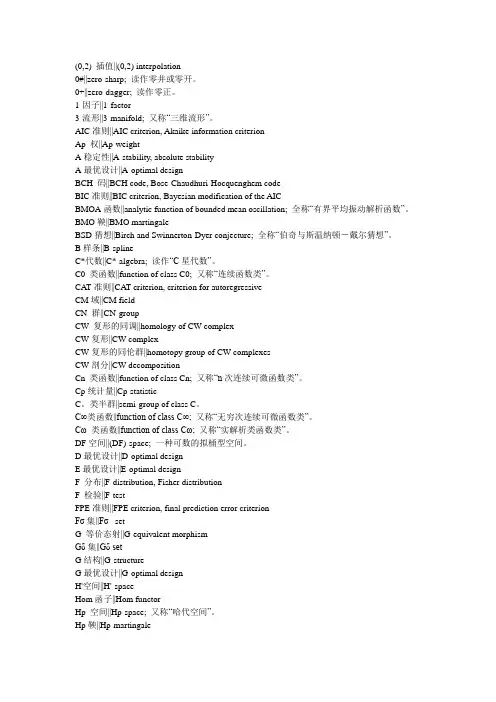
(0,2) 插值||(0,2) interpolation0#||zero-sharp; 读作零井或零开。
0+||zero-dagger; 读作零正。
1-因子||1-factor3-流形||3-manifold; 又称“三维流形”。
AIC准则||AIC criterion, Akaike information criterionAp 权||Ap-weightA稳定性||A-stability, absolute stabilityA最优设计||A-optimal designBCH 码||BCH code, Bose-Chaudhuri-Hocquenghem codeBIC准则||BIC criterion, Bayesian modification of the AICBMOA函数||analytic function of bounded mean oscillation; 全称“有界平均振动解析函数”。
BMO鞅||BMO martingaleBSD猜想||Birch and Swinnerton-Dyer conjecture; 全称“伯奇与斯温纳顿-戴尔猜想”。
B样条||B-splineC*代数||C*-algebra; 读作“C星代数”。
C0 类函数||function of class C0; 又称“连续函数类”。
CA T准则||CAT criterion, criterion for autoregressiveCM域||CM fieldCN 群||CN-groupCW 复形的同调||homology of CW complexCW复形||CW complexCW复形的同伦群||homotopy group of CW complexesCW剖分||CW decompositionCn 类函数||function of class Cn; 又称“n次连续可微函数类”。
Cp统计量||Cp-statisticC。
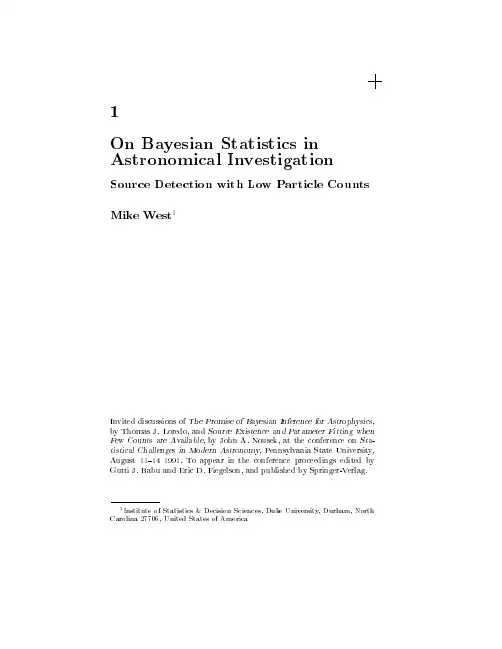
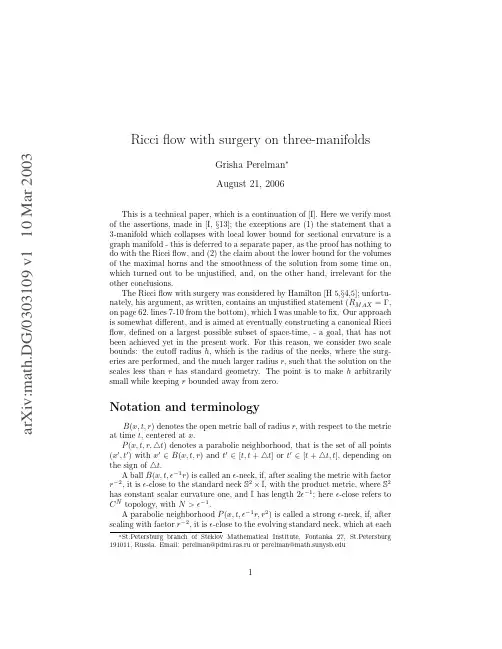
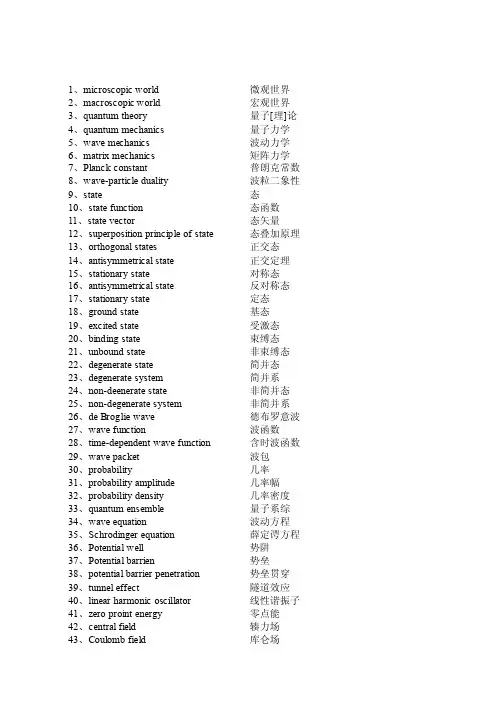
1、microscopic world 微观世界2、macroscopic world 宏观世界3、quantum theory 量子[理]论4、quantum mechanics 量子力学5、wave mechanics 波动力学6、matrix mechanics 矩阵力学7、Planck constant 普朗克常数8、wave-particle duality 波粒二象性9、state 态10、state function 态函数11、state vector 态矢量12、superposition principle of state 态叠加原理13、orthogonal states 正交态14、antisymmetrical state 正交定理15、stationary state 对称态16、antisymmetrical state 反对称态17、stationary state 定态18、ground state 基态19、excited state 受激态20、binding state 束缚态21、unbound state 非束缚态22、degenerate state 简并态23、degenerate system 简并系24、non-deenerate state 非简并态25、non-degenerate system 非简并系26、de Broglie wave 德布罗意波27、wave function 波函数28、time-dependent wave function 含时波函数29、wave packet 波包30、probability 几率31、probability amplitude 几率幅32、probability density 几率密度33、quantum ensemble 量子系综34、wave equation 波动方程35、Schrodinger equation 薛定谔方程36、Potential well 势阱37、Potential barrien 势垒38、potential barrier penetration 势垒贯穿39、tunnel effect 隧道效应40、linear harmonic oscillator线性谐振子41、zero proint energy 零点能42、central field 辏力场43、Coulomb field 库仑场44、δ-function δ-函数45、operator 算符46、commuting operators 对易算符47、anticommuting operators 反对易算符48、complex conjugate operator 复共轭算符49、Hermitian conjugate operator 厄米共轭算符50、Hermitian operator 厄米算符51、momentum operator 动量算符52、energy operator 能量算符53、Hamiltonian operator 哈密顿算符54、angular momentum operator 角动量算符55、spin operator 自旋算符56、eigen value 本征值57、secular equation 久期方程58、observable 可观察量59、orthogonality 正交性60、completeness 完全性61、closure property 封闭性62、normalization 归一化63、orthonormalized functions 正交归一化函数64、quantum number 量子数65、principal quantum number 主量子数66、radial quantum number 径向量子数67、angular quantum number 角量子数68、magnetic quantum number 磁量子数69、uncertainty relation 测不准关系70、principle of complementarity 并协原理71、quantum Poisson bracket 量子泊松括号72、representation 表象73、coordinate representation 坐标表象74、momentum representation 动量表象75、energy representation 能量表象76、Schrodinger representation 薛定谔表象77、Heisenberg representation 海森伯表象78、interaction representation 相互作用表象79、occupation number representation 粒子数表象80、Dirac symbol 狄拉克符号81、ket vector 右矢量82、bra vector 左矢量83、basis vector 基矢量84、basis ket 基右矢85、basis bra 基左矢86、orthogonal kets 正交右矢87、orthogonal bras 正交左矢88、symmetrical kets 对称右矢89、antisymmetrical kets 反对称右矢90、Hilbert space 希耳伯空间91、perturbation theory 微扰理论92、stationary perturbation theory 定态微扰论93、time-dependent perturbation theory 含时微扰论94、Wentzel-Kramers-Brillouin method W. K. B.近似法95、elastic scattering 弹性散射96、inelastic scattering 非弹性散射97、scattering cross-section 散射截面98、partial wave method 分波法99、Born approximation 玻恩近似法100、centre-of-mass coordinates 质心坐标系101、laboratory coordinates 实验室坐标系102、transition 跃迁103、dipole transition 偶极子跃迁104、selection rule 选择定则105、spin 自旋106、electron spin 电子自旋107、spin quantum number 自旋量子数108、spin wave function 自旋波函数109、coupling 耦合110、vector-coupling coefficient 矢量耦合系数111、many-partic le system 多子体系112、exchange forece 交换力113、exchange energy 交换能114、Heitler-London approximation 海特勒-伦敦近似法115、Hartree-Fock equation 哈特里-福克方程116、self-consistent field 自洽场117、Thomas-Fermi equation 托马斯-费米方程118、second quantization 二次量子化119、identical particles全同粒子120、Pauli matrices 泡利矩阵121、Pauli equation 泡利方程122、Pauli’s exclusion principle泡利不相容原理123、Relativistic wave equation 相对论性波动方程124、Klein-Gordon equation 克莱因-戈登方程125、Dirac equation 狄拉克方程126、Dirac hole theory 狄拉克空穴理论127、negative energy state 负能态128、negative probability 负几率129、microscopic causality 微观因果性本征矢量eigenvector本征态eigenstate本征值eigenvalue本征值方程eigenvalue equation本征子空间eigensubspace (可以理解为本征矢空间)变分法variatinial method标量scalar算符operator表象representation表象变换transformation of representation表象理论theory of representation波函数wave function波恩近似Born approximation玻色子boson费米子fermion不确定关系uncertainty relation狄拉克方程Dirac equation狄拉克记号Dirac symbol定态stationary state定态微扰法time-independent perturbation定态薛定谔方程time-independent Schro(此处上面有两点)dinger equation 动量表象momentum representation角动量表象angular mommentum representation占有数表象occupation number representation坐标(位置)表象position representation角动量算符angular mommentum operator角动量耦合coupling of angular mommentum对称性symmetry对易关系commutator厄米算符hermitian operator厄米多项式Hermite polynomial分量component光的发射emission of light光的吸收absorption of light受激发射excited emission自发发射spontaneous emission轨道角动量orbital angular momentum自旋角动量spin angular momentum轨道磁矩orbital magnetic moment归一化normalization哈密顿hamiltonion黑体辐射black body radiation康普顿散射Compton scattering基矢basis vector基态ground state基右矢basis ket ‘右矢’ket基左矢basis bra简并度degenerancy精细结构fine structure径向方程radial equation久期方程secular equation量子化quantization矩阵matrix模module模方square of module内积inner product逆算符inverse operator欧拉角Eular angles泡利矩阵Pauli matrix平均值expectation value (期望值)泡利不相容原理Pauli exclusion principle氢原子hydrogen atom球鞋函数spherical harmonics全同粒子identical partic les塞曼效应Zeeman effect上升下降算符raising and lowering operator 消灭算符destruction operator产生算符creation operator矢量空间vector space守恒定律conservation law守恒量conservation quantity投影projection投影算符projection operator微扰法pertubation method希尔伯特空间Hilbert space线性算符linear operator线性无关linear independence谐振子harmonic oscillator选择定则selection rule幺正变换unitary transformation幺正算符unitary operator宇称parity跃迁transition运动方程equation of motion正交归一性orthonormalization正交性orthogonality转动rotation自旋磁矩spin magnetic monent(以上是量子力学中的主要英语词汇,有些未涉及到的可以自由组合。
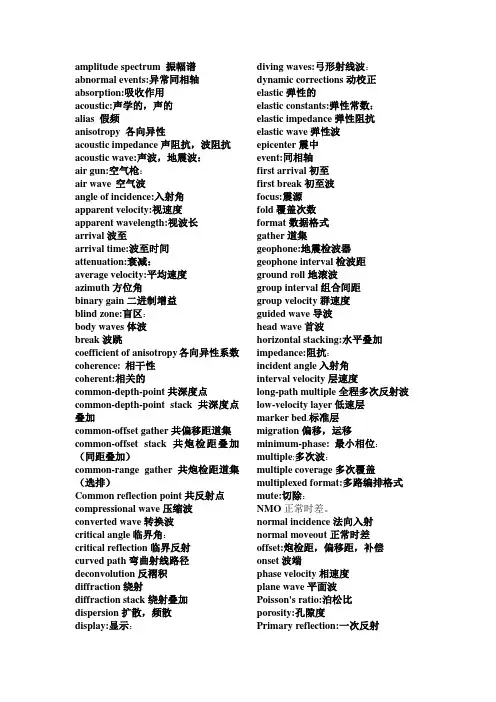
amplitude spectrum 振幅谱abnormal events:异常同相轴absorption:吸收作用acoustic:声学的,声的alias 假频anisotropy 各向异性acoustic impedance声阻抗,波阻抗acoustic wave:声波,地震波:air gun:空气枪:air wave空气波angle of incidence:入射角apparent velocity:视速度apparent wavelength:视波长arrival波至arrival time:波至时间attenuation:衰减:average velocity:平均速度azimuth方位角binary gain二进制增益blind zone:盲区:body waves体波break波跳coefficient of anisotropy各向异性系数coherence:相干性coherent:相关的common-depth-point共深度点common-depth-point stack共深度点叠加common-offset gather共偏移距道集common-offset stack共炮检距叠加(同距叠加)common-range gather共炮检距道集(选排)Common reflection point共反射点compressional wave压缩波converted wave转换波critical angle临界角:critical reflection临界反射curved path弯曲射线路径deconvolution反褶积diffraction绕射diffraction stack绕射叠加dispersion扩散,频散display:显示:diving waves:弓形射线波:dynamic corrections动校正elastic弹性的elastic constants:弹性常数:elastic impedance弹性阻抗elastic wave弹性波epicenter震中event:同相轴first arrival初至first break初至波focus:震源fold覆盖次数format数据格式gather道集geophone:地震检波器geophone interval检波距ground roll地滚波group interval组合间距group velocity群速度guided wave导波head wave首波horizontal stacking:水平叠加impedance:阻抗:incident angle入射角interval velocity层速度long-path multiple全程多次反射波low-velocity layer低速层marker bed.标准层migration偏移,运移minimum-phase:最小相位:multiple:多次波:multiple coverage多次覆盖multiplexed format:多路编排格式mute:切除:NMO正常时差。
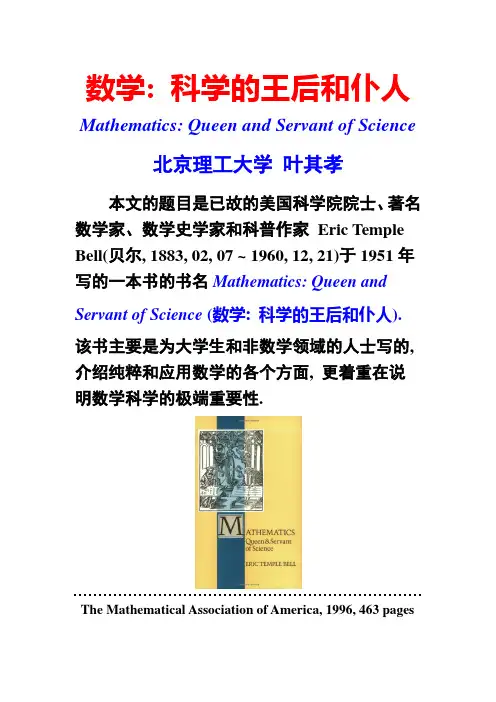
数学: 科学的王后和仆人Mathematics: Queen and Servant of Science北京理工大学叶其孝本文的题目是已故的美国科学院院士、著名数学家、数学史学家和科普作家Eric Temple Bell(贝尔, 1883, 02, 07 ~ 1960, 12, 21)于1951年写的一本书的书名Mathematics: Queen and Servant of Science (数学: 科学的王后和仆人). 该书主要是为大学生和非数学领域的人士写的, 介绍纯粹和应用数学的各个方面, 更着重在说明数学科学的极端重要性.The Mathematical Association of America, 1996, 463 pages实际上这是他1931年写的The Queen of the Sciences (科学的王后)和1937年写的The Handmaiden of the Sciences (科学的女仆)这两本通俗数学论著的合一修订扩大版.Eric Temple Bell Alexander Graham Bell (1847 ~ 1922) 按常识的理解, 女王是优美、高雅、无懈可击、至尊至贵的, 在科学中只有纯粹数学才具有这样的特点, 简洁明了的数学定理一经证明就是永恒的真理, 极其优美而且无懈可击;另一方面, 科学和工程的各个分支都在不同程度上大量应用数学, 这时数学科学就是仆人, 这些仆人是否强有力, 用起来是否得心应手是雇佣这些仆人的主人最为关心的事. 事实上, servant这个字本身就有“供人们利用之物, 有用的服务工具”的意思. 毫无疑问, 我们的目的不是为数学争一个好的名分, 而是想说明数学是怎样通过数学建模来解决各种实际问题的; 数学(数学建模)的极端重要性, 以及探讨正确认识和理解数学科学的作用对于发展我国科学技术、经济以及教育, 从而争取在21世纪把我国真正建设成为屹立于世界民族之林的强国,乃至个人事业发展的至关重要性. 当然, 我们也希望说明王后和仆人集于一身并不矛盾. 历史上, 很多特别受人尊敬的科学家, 不仅仅是由于他们的科学成就, 更因为他们的科学成就能够服务于人类.数学是科学的王后, 算术是数学的王后. 她常常放下架子为天文学和其他科学效劳, 但是在所有情况下, 第一位的是她(数学)应尽的责任. (高斯)Mathematics is the Queen of the Sciences, and Arithmetic the Queen of Mathematics. She often condescends to render service to astronomy and other natural sciences, but under all circumstance the first place is her due.— Carl Friedrich Gauss (卡尔·弗里德里希·高斯, 1777, 4, 30 ~ 1855, 2, 23)From: Bell, Eric T., Mathematics: Queen and Servant of Science, MAA, 1951, p.1;Men of Mathematics, Simon and Schuster, New York, 1937, p. xv.***************************************************自古以来,数学的发展始终与科学技术的发展紧密相连,反之亦然. 首先, 我们来看一下导致我们现在这个飞速发展的信息社会的19、20世纪几乎所有重大科学理论的发展和完善过程中数学(数学建模)所起到的不可勿缺的作用.数学研究的成果往往是重大科学发明的催生素(仅就19、20世纪而言, 流体力学、电磁理论、相对论、量子力学、计算机、信息论、控制论、现代经济学、万维网和互联网搜索引擎、生物学、CT、甚至社会政治学领域等). 但是20世纪上半世纪, 数学虽然也直接为工程技术提供一些工具, 但基本方式是间接的: 先促进其他科学的发展, 再由这些科学提供工程原理和设计的基础. 数学是幕后的无名英雄.现在, 数学无处不在, 数学和工程技术之间,在更广阔的范围内和更深刻的程度上, 直接地相互作用着, 极大地推动了科学和工程科学的发展, 也极大地推动了技术的发展. 数学不仅是幕后的无名英雄, 很多方面开始走向“前台”. 但是对数学的极端重要性迄今尚未有共识, 取得共识对加强一个国家的竞争力来说是至关重要的.硬能力―一位美国朋友谈及对未来中国人的看法: 20年后, 中国年轻人会丢了中国人现在的硬能力, 他们崇拜各种明星, 不愿献身科学, 不再以学术研究为荣, 聪明拔尖的学生都去学金融、法律等赚钱的专业; 而美国人因为认识到其硬能力(例如数学)不行, 进行教育改革, 20年后, 不但保持了其软实力即非专业能力的优势, 而且在硬能力上赶上中国人.‖“正在丢失的硬实力”, 鲁鸣, 《青年文摘》2011年第5期动向:美国很多州新办STEM高中, 一些大学开始开设STEM课程等.STEM = Science + Technology + Engineering + Mathematics2012年2月7日公布的美国总统科技顾问委员会给总统的报告,参与超越:培养额外的100万具有科学、技术、工程和数学学位的大学生(Engage to Excel: Producing One Million Additional College Graduates with Degrees in Science, Technology, Engineering, and Mathematics)The Mathematical Sciences in 2025, the National Academies Press, 2013人们使用的数学科学思想、概念和方法的范围在不断扩大的同时,数学科学的用途也在不断扩展. 21世纪的大部分科学与工程将建立在数学科学的基础上.This major expansion in the uses of the mathematical sciences has been paralleled by a broadening in the range of mathematical science ideas and techniques being used. Much of twenty-first century science and engineering is going to be built on a mathematical science foundation, and that foundation must continue to evolve and expand.数学科学是日常生活的几乎每个方面的组成部分.互联网搜索、医疗成像、电脑动画、数值天气预报和其他计算机模拟、所有类型的数字通信、商业和军事中的优化问题以及金融风险的分析——普通公民都从支撑这些应用功能的数学科学的各种进展中获益,这样的例子不胜枚举.The mathematical sciences are part of almost every aspect of everyday life. Internet search, medical imaging, computer animation, numerical weather predictions and othercomputer simulations, digital communications of all types, optimization in business and the military, analyses of financial risks —average citizens all benefit from the mathematical science advances that underpin these capabilities, and the list goes on and on.调查发现:数学科学研究工作正日益成为生物学、医学、社会科学、商业、先进设计、气候、金融、先进材料等许多研究领域不可或缺的重要组成部分. 这种研究工作涉及最广泛意义下数学、统计学和计算综合,以及这些领域与潜在应用领域的相互作用. 所有这些活动对于经济增长、国家竞争力和国家安全都是至关重要的,而且这种事实应该对作为整体的数学科学的资助性质和资助规模产生影响. 数学科学的教育也应该反映数学科学领域的新的状况.Finding: Mathematical sciences work is becoming an increasingly integral and essential component of a growing array of areas of investigation in biology, medicine, social sciences, business, advanced design, climate, finance, advanced materials, and many more. This work involves the integration of mathematics, statistics, and computation in the broadest sense and the interplay of these areas withareas of potential application. All of these activities are crucial to economic growth, national competitiveness, and national security, and this fact should inform both the nature and scale of funding for the mathematical sciences as a whole. Education in the mathematical sciences should also reflect this new stature of the field.****************************************************************为了以下讲述的方便, 我们先来了解一下什么是数学建模.数学模型(Mathematical Model)是用数学符号对一类实际问题或实际发生的现象的(近似的)描述.数学建模(Mathematical Modeling)则是获得该模型并对之求解、验证并得到结论的全过程.数学建模不仅是了解基本规律, 而且从应用的观点来看更重要的是预测和控制所建模的系统的行为的强有力的工具.数学建模是数学用来解决各种实际问题的桥梁.↑→→→→→→→→↓↑↓↑↓↓↑↓←←←←←通不过↓↓通过)定义:数学建模就是上述框图多次执行的过程数学建模的难点观察、分析实际问题, 作出合理的假设, 明确变量和参数, 形成明确的数学问题. 不仅仅是翻译的问题; 涉及的数学问题可能是复杂、困难的, 求解也许涉及深刻的数学方法. 如何作出正确的判断, 寻找合适、简洁的(解析或近似) 解法; 如何验证模型.简言之:合理假设、模型建立、模型求解、解释验证.记住这16个字, 将会终生受用.数学建模的重要作用:源头创新当然数学建模也有局限性, 不能单独包打天下, 因为实际问题是非常复杂的, 需要多学科协同解决.在图灵(A. M. Turing)的文章: The Chemical Basis of Morphogenesis (形态生成的化学基础), Philosophical Transactions of the Royal Society of London (伦敦皇家学会哲学公报), Series B (Biological Sciences),v.237(1952), 37-72.1. 一个胚胎的模型. 成形素本节将描述一个正在生长的胚胎的数学模型. 该模型是一种简化和理想化, 因此是对原问题的篡改. 希望本文论述中保留的一些特征, 就现今的知识状况而言, 是那些最重要的特征.1. A model of the embryo. MorphogensIn this section a mathematical model of the growing embryo will be described. This model will be asimplification and an idealization, and consequently a falsification. It is to be hoped that the features retained for discussion are those of greatest importance in the present state of knowledge.想单靠数学建模本身来解决重大的生物学问题是不可能的,另一方面,想仅仅依靠实验来获得对生物学的合理、完整的理解也是极不可能的. There is no way mathematical modeling can solve major biological problems on its own. On the other hand, it ishighly unlikely that even a reasonably complete understanding could come solely from experiment.—— J. D. Murray, Why Are There No 3-Headed Monsters? Mathematical Modeling in Biology, Notices of the AMS,v. 59 (2012), no. 6, p.793.自古以来公平、公正的竞赛都是培养、选拔人才的重要手段, 科学和数学也不例外.中学生IMO (国际数学奥林匹克(International Mathematical Olympiad), 1959 ~)北美的大学生Putnbam数学竞赛(1938 ~)全国大学生数学竞赛(2010 ~)Mathematical Contest in Modeling (MCM, 1985 ~)美国大学生数学建模竞赛Interdisciplinary Contest in Modeling (ICM, 1999~)美国大学生跨学科建模竞赛China Undergraduate Mathematical Contest in Modeling (CUMCM, 1992~) 中国大学生数学建模竞赛中国大学生参加美国大学生数学建模竞赛情况中国大学生数学建模竞赛情况在以下讲述中涉及物理方面的具体的数学模型 (问题)的叙述和初步讨论可参考《物理学与偏微分方程》, 李大潜、秦铁虎编著, (上册, 1997; 下册, 2000), 高等教育出版社.Seven equations that rule your world (主宰你生活的七个方程式), by Ian Stewart, NewScientist, 13 February 2012.Fourier transformation 2ˆ()()ix f f x e dx πξξ∞--∞=⎰Wave equation 22222u u c t x ∂∂=∂∂ Ma xwell‘s equation110, , 0, H E E E H H c t c t∂∂∇⋅=∇⨯=-∇⋅=∇⨯=∂∂Schrödinger‘s equation ˆψH ψi t∂=∂Ian Stewart, In Pursuit of the Unknown:17 Equations That Changed the World (追求对未知的认识:改变世界的17个方程), Basic Books, March 13, 2012.目录(Contents)Why Equations? /viii1. The squaw on the hippopotamus ——Pythagoras‘sTheorem/12. Shortening the proceedings —— Logarithms/213. Ghosts of departed quantities —— Calculus/354. The system of the world ——Newton‘s Law ofGravity/535. Portent of the ideal world —— The Square Root ofMinus One/736. Much ado about knotting ——Euler‘s Formula forPolyhedra/837. Patterns of chance —— Normal Distribution/1078. Good vibrations —— Wave Equation/1319. Ripples and blips —— Fourier Transform/14910. The ascent of humanity —— Navier-StokesEquation/16511. Wave in the ether ——Maxwell‘s Equations/17912. Law and disorder —— Second Law ofThermodynamics /19513. One thing is absolute —— Relativity/21714. Quantum weirdness —— Schrödinger Equation/24515. Codes, communications, and computers ——Information Theory/26516. The imbalance of nature —— Chaos Theory/28317. The Midas formula —— Black-Scholes Equation/195Where Next?/317Notes/321Illustration Credits/330Index/331相对论Albert Einstein(1879, 3, 14 ~1955, 4, 18)20世纪最伟大的科学成就莫过于Einstein(爱因斯坦)的狭义和广义相对论了, 但是如果没有Minkowski (闵可夫斯基)几何、Riemann(黎曼)于1854年发明的Riemann几何, 以及Cayley(凯莱), Sylvester(西勒维斯特)和Noether(诺特)等数学家发展的不变量理论, Einstein的广义相对论和引力理论就不可能有如此完善的数学表述. Einstein自己也不止一次地说过.早在1905年, 年仅26岁的爱因斯坦就已提出了狭义相对论. 狭义相对论推倒了牛顿力学的质量守恒、能量守恒、质量能量互不相关、时空永恒不变的基本命题. 这是一场真正的科学革命.为了导出狭义相对论,爱因斯坦作出了两个假设:运动的相对性(所有匀速运动都是相对的)和光速为常数(光的运动例外, 它是绝对的). (1)狭义相对性原理,即在所有惯性系中, 物理学定律具有相同的数学表达形式;(2)光速不变原理,真空中光沿各个方向传播的速率都相等,与光源和观察者的运动状态无关.时空不是绝对独立的.由此可以导出一些推论: 相对论坐标变换式和速度变换式, 同时的相对性, 钟慢尺缩效应和质能关系式等.他的好友物理学家P.Ehrenfest指出实际上还蕴涵着第三个假设, 即这两个假设是不矛盾的. 物体运动的相对性和光速的绝对性, 两者之间的相互制约和作用乃是相对论里一切我们不熟悉的时空特征的根源.(部分参阅李新洲:《寻找自然之律--- 20世纪物理学革命》, 上海科技教育出版社, 2001.)1907 年德国数学家H. Minkowski (1864 ~1909) 提出了―Minkowski 空间‖,即把时间和空间融合在一起的四维空间1,3R. Minkowski 几何为Einstein 狭义相对论提供了合适的数学模型.“没有任何客观合理的方法能够把四维连续统分离成三维空间连续统和一维时间连续统. 因此从逻辑上讲, 在四维时空连续统(space- time continuum)中表述自然定律会更令人满意. 相对论在方法上的巨大进步正是建立在这个基础之上的, 这种进步归功于闵可夫斯基(Minkowski).”—Albert Einstein, The Meaning of Relativity, 1922, Princeton University Press. 中译本, 阿尔伯特·爱因斯坦著, 相对论的意义, (普林斯顿科学文库(Princeton Science Library) 1), 郝建纲、刘道军译, 上海科技教育出版社, 2001, p. 27.有了Minkowski 时空模型后, Einstein 又进一步研究引力场理论以建立广义相对论. 1912 年夏他已经概括出新的引力理论的基本物理原理, 但是为了实现广义相对论的目标, 还必须寻求理论的数学结构, Einstein 为此花了 3 年的时间, 最后, 在数学家M. Grossmann 的介绍下学习掌握了发展相对论引力学说所必需的数学工具—以Riemann几何和Ricci, Levi - Civita的绝对微分学, 也就是Einstein 后来所称的张量分析.“根据前面的讨论, 很显然, 如果要表达广义相对论, 就需要对不变量理论以及张量理论加以推广. 这就产生了一个问题, 即要求方程的形式必须对于任意的点变换都是协变的. 在相对论产生以前很久, 数学家们就已经建立了推广的张量演算理论. 黎曼(Riemann)首先把高斯(Gauss)的思路推广到了任意维连续统, 他很有预见性地看到了……进行这种推广的物理意义. 随后, 这个理论以张量微积分的形式得到了发展, 对此里奇(Ricci)和莱维·齐维塔(Tulio Levi-Civita, 1873~1941)做出了重要贡献. ”—阿尔伯特·爱因斯坦著, 相对论的意义, 郝建纲、刘道军译, 上海科技教育出版社, 2001, p. 57.从数学建模的角度看, 广义相对论讨论的中心问题是引力理论, 其基础是以下两个假设: 1. (等效原理)惯性力场与引力场的动力学效应是局部不可分辨的,(或说引力和非惯性系中的惯性力等效);2. (广义相对性原理) 一切参考系都是平权的,换言之,客观的真实的物理规律应该在任意坐标变换下形式不变——广义协变性(即一切物理定律在所有参考系[无论是惯性的或非惯性的]中都具有相同的形式)。
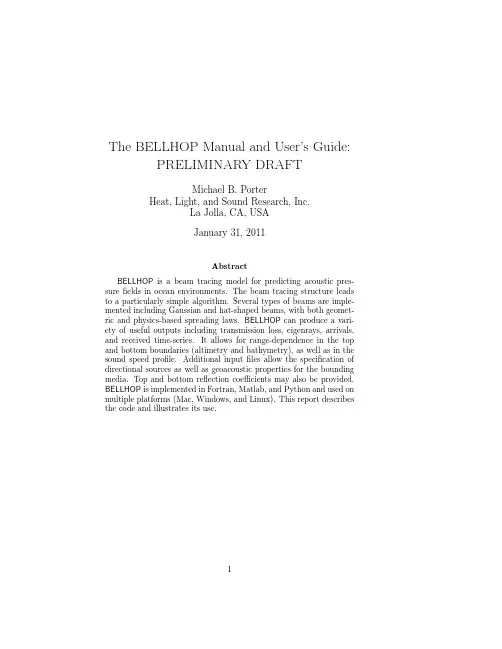
The BELLHOP Manual and User’s Guide: PRELIMINARY DRAFTMichael B.PorterHeat,Light,and Sound Research,Inc.La Jolla,CA,USAJanuary31,2011AbstractBELLHOP is a beam tracing model for predicting acoustic pres-surefields in ocean environments.The beam tracing structure leads to a particularly simple algorithm.Several types of beams are imple-mented including Gaussian and hat-shaped beams,with both geomet-ric and physics-based spreading laws.BELLHOP can produce a vari-ety of useful outputs including transmission loss,eigenrays,arrivals, and received time-series.It allows for range-dependence in the top and bottom boundaries(altimetry and bathymetry),as well as in the sound speed profile.Additional inputfiles allow the specification of directional sources as well as geoacoustic properties for the bounding media.Top and bottom reflection coefficients may also be provided. BELLHOP is implemented in Fortran,Matlab,and Python and used on multiple platforms(Mac,Windows,and Linux).This report describes the code and illustrates its use.12Contents1Map of the BELLHOP program51.1Input (5)1.2Output (5)2Sound speed profile and ray trace9 3Eigenray plots17 4Transmission Loss214.1Coherent,Semicoherent,and Incoherent TL (25)5Directional Sources27 6Range-dependent Boundaries316.1Piecewise-Linear Boundaries:Dickins seamount (31)6.2Plotting a single beam (34)6.3Curvilinear Boundaries:Parabolic Bottom (35)7Tabulated Reflection Coefficients39 8Range-dependent Sound Speed Profiles41 9Arrivals calculations and broadband results459.1Coherent and Incoherent TL (45)9.2Plotting the impulse response (51)9.3Generating a receiver timeseries (53)10Acknowledgments57341Map of the BELLHOP program1.1InputThe overall structure of BELLHOP is shown in Fig.(1).Variousfiles must be provided to describe the environment and the geometry of sources and receivers.In the simplest case,which is also typical,there is only one such file.It is referred to as an environmentalfile and includes the sound speed profile,as well as information about the ocean bottom.However,if there is a range-dependent bottom,then one must add a bathymetryfile with range-depth pairs defining the water depth.Similarly,if there is a range-dependent ocean sound speed,the one must an an SSPfile with the sound speed tabulated on a regular grid.Further,if one wants to specify an ar-bitrary bottom reflection coefficient to characterize the bottom,then one must provide a bottom reflection coefficientfile with angle-reflection coeffi-cient pairs defining the reflectivity.Similar capabilities are implemented for the surface.Thus there is the option of providing a top reflection coefficient and a top shape(called an altimetryfile).Usually one assumes the acoustic source is omni-directional;however,if there is a source beampattern,then one must provide a source beam pattern file with angle-amplitude pairs defining it.BELLHOP reads thesefiles depending on options selected within the main environmentalfile.Plot programs(plotssp,plotbty,plotbrc,etc.)are provided to display each of the inputfiles.1.2OutputBELLHOP produces different outputfiles depending on the options selected within the main environmentalfile.Usually one starts with a ray tracing option,which produces afile con-taining a fan of rays emanating from the source.If the eigenray option is selected,then the fan is winnowed to include only the rays that bracket a specified receiver location.Thefile format is identical to that used in the standard ray-tracing option.Rayfiles are usually used to get a sense of how energy is propagating in the channel.The program plotray is used to display thesefiles.Usually one is interested in calculating the transmission loss for a tonal source(or for a single tone of interest in a broadband waveform).The transmission loss is essentially the sound intensity due to a source of unit strength.The transmission loss information is written to a shadefile which5plotrayplotshdplottlrplotarrsource timeseries generatorplotts plotsspplotbtyplotbrcplotssp2DFigure1:BELLHOP structure.6can be displayed as a2D surface using plotshd,or in range and depth slices, using plottlr and plottld respectively.If one wants to get not just the intensity due to a tonal source,but the entire timeseries then one selects an arrivals calculation.The resulting arrivalsfile contains amplitude-delay pairs defining the loudness and delay for every echo in the channel.This information can be plotted using plotarr to show the echo pattern.Alternatively it can be passed to a convolver, which sums up the echoes of a particular source timeseries to produce a receiver timeseries.The program plotts can be used to plot either the source or receiver timeseries.782Sound speed profile and ray traceAs afirst example,we consider a deep water case with the Munk sound speed profiually one should start by plotting the sound speed profile and doing a ray trace.The inputfile(also called an environmentalfile)isa simple textfile created using any standard text editor and must have a’.env’extension.It is usually easiest to start from one of the examplefiles.Here we consider at/tests/Munk/MunkB ray.env:MunkB ray.env1’Munk profile’!TITLE250.0!FREQ(Hz)31!NMEDIA4’SVF’!SSPOPT(Analytic or C-linear interpolation) 5510.05000.0!DEPTH of bottom(m)60.01548.52/7200.01530.29/8250.01526.69/9400.01517.78/10600.01509.49/11800.01504.30/121000.01501.38/131200.01500.14/141400.01500.12/151600.01501.02/161800.01502.57/172000.01504.62/182200.01507.02/192400.01509.69/202600.01512.55/212800.01515.56/223000.01518.67/233200.01521.85/243400.01525.10/253600.01528.38/263800.01531.70/274000.01535.04/284200.01538.39/294400.01541.76/304600.01545.14/314800.01548.52/325000.01551.91/33’A’0.0345000.01600.000.01.0/351!NSD361000.0/!SD(1:NSD)(m)3751!NRD380.05000.0/!RD(1:NRD)(m)9391001!NR400.0100.0/!R(1:NR)(km)41’R’!’R/C/I/S’4241!NBeams43-20.020.0/!ALPHA1,2(degrees)440.05500.0101.0!STEP(m),ZBOX(m),RBOX(km) The inputfile is read using list-directed i/o,so the data does not need to be precisely positioned on each line.As a convenience we also append comments,preceded by’!’.These are optional and are not read by the program.The source frequency(line2)is not terribly important for the basic ray trace.The rays are frequency independent;however,the frequency can have an impact on the ray step size,since the code assumes more accurate ray trajectories will be needed at higher frequencies.NMedia(line3)is always set to one in BELLHOP.This parameter is included for compatibility with other models in the Acoustics Toolbox,which are capable of handling multi-layered problems.The top option(line4)is next specifed as‘SVF’indicating that a spline fit should be used to interpolate the sound speed profile;that the ocean sur-face is modeled as a vacuum;and that all attenuation values are specified in dB/mkHz.We chose the splinefit here knowing that the profile is smoothly varying.In such cases,the splinefit produces smoother looking ray trace plots.The only important parameter in the next line(5)is the bottom depth (5000m),which indicates the last line that needs to be read in the sound speed profile.Thefirst two parameters are not used by BELLHOP.Next we see a sequence of depth-soundspeed pairs defining the ocean soundspeed profile.The last value in the soundspeed profile must start with the previously specified value for the bottom depth.To ensure compatibility with the other models in the Acoustics Toolbox,we normally terminate each line with a’/’.The other models are expecting attenuations,shear speeds, and a density as additional parameters and the’/’tells them to stop reading the line and use default values.Next we have two lines specifying the bottom boundary.The option letter‘A’indicates that the bottom is to be modeled as an Acousto-Elastic halfspace.The lines following specify that halfspace as having a sound speed of1500m/s and unit density(which is not very realistic).The next6lines specify the source depths,receiver depths,and receiver ranges.Depths are always specified in meters and ranges in kilometers.10For ourfirst run,we are producing a ray trace so the receiver locations are irrelevant;however,they do need to be provided.Note also that51 receiver depths have been specified.Often the user simply wants a uniform distribution of receiver depths to display the acousticfield.To avoid forcing the user to type in all those numbers one has the option of simply putting in thefirst and last values and terminating the line with a’/’.The code detects the premature termination and then produces a full set of receivers by interpolation.The sources and receivers must lie within the interior of the waveguide.The choice of units is motivated by typical ocean acoustic scenarios. However,fundamentally the code is simply solving the wave equation so any self-consistent set of units could be used.Next is the RunType(line41).For a raytrace run,we select option‘R’. The following lines then specify the fan that will be used,given as a number of rays,together with the angular limits in degrees.We follow a convention that the angles are specified in declination,i.e.zero degrees is a horizontally launched ray,and a positive angle is a ray launched towards the bottom.For a ray trace run,the plot usually becomes too cluttered if we use more than about50rays.This is a matter of taste.Likewise,the angular limits are determined by what part of thefield the user is interested in seeing.The last line(44)specifies the step size in meters used to trace a ray, along with the depth and range of a box beyond which no rays are traced. Usually,a step size of0should be selected and then BELLHOP will make an automatic selection of about a tenth of the water depth.Regardless of what step size is selected,BELLHOP dynamically adjusts the step size as the ray is traced,to ensure that each ray lands precisely on all depths where a sound speed is given.Thus,the sound speed profile itself usually controls the ray step size.If you provide more sound speed points than are necessary, BELLHOP will similarly run slower.On the other hand,for a given sampling of the sound speed profile,you may be able to obtain a more accurate ray trace by specifying a step size that is smaller than the default value.Now that the inputfile has been created,we can start by plotting the soundspeed profile,using the Matlab routine plotssp.m.The syntax of the Matlab command to run this is:plotssp’MunkB ray’where’MunkB ray.env’is the name of the BELLHOP inputfile.This pro-duces the plot in Fig.(2).1115001510152015301540155015600500100015002000250030003500400045005000Sound Speed (m/s)D e p t h (m )Figure 2:The Munk sound speed profile.We started first with the sound speed profile plot,to introduce the sce-nario in a logical fashion.However,in practice it is recommended to do a trial BELLHOP run on the input file first.BELLHOP will produce a print file as show below,which echoes the input data in a clear format.In addition,it will stop at the first place it encounters something unintelligible.Thus,by examining the print file one can usually see clearly any formatting errors.MunkB ray.prt1BELLHOP-Munkprofile 2frequency =50.00Hz34Dummy parameter NMedia =156SPLINE approximation to SSP7Attenuation units:dB/mkHz 8VACUUM 910Depth =5000.0000000000000m1112Spline SSP option 1314Sound speed profile:150.001548.5216200.001530.2917250.001526.6918400.001517.781219600.001509.4920800.001504.30211000.001501.38221200.001500.14231400.001500.12241600.001501.02251800.001502.57262000.001504.62272200.001507.02282400.001509.69292600.001512.55302800.001515.56313000.001518.67323200.001521.85333400.001525.10343600.001528.38353800.001531.70364000.001535.04374200.001538.39384400.001541.76394600.001545.14404800.001548.52415000.001551.914243(RMS roughness=0.00)44ACOUSTO-ELASTIC half-space455000.001600.000.00 1.000.00000.0000 4647Number of sources=148Source depths(m)491000.005051Number of receivers=5152Receiver depths(m)530.00000100.000200.000300.000400.000 54500.000600.000700.000800.000900.000 551000.001100.001200.001300.001400.00 561500.001600.001700.001800.001900.00 572000.002100.002200.002300.002400.00 582500.002600.002700.002800.002900.00 593000.003100.003200.003300.003400.00 603500.003600.003700.003800.003900.00 614000.004100.004200.004300.004400.00 624500.004600.004700.004800.004900.00 635000.006465Number of ranges=100166Receiver ranges(km)670.000000.1000000.2000000.3000000.40000013680.5000000.6000000.7000000.8000000.90000069 1.00000 1.10000 1.20000 1.30000 1.4000070 1.50000 1.60000 1.70000 1.80000 1.9000071 2.00000 2.10000 2.20000 2.30000 2.4000072 2.50000 2.60000 2.70000 2.80000 2.9000073 3.00000 3.10000 3.20000 3.30000 3.4000074 3.50000 3.60000 3.70000 3.80000 3.9000075 4.00000 4.10000 4.20000 4.30000 4.4000076 4.50000 4.60000 4.70000 4.80000 4.9000077 5.0000078...100.0000007980Ray trace run81Geometric beams82Point source(cylindrical coordinates)83Rectilinear receiver grid:Receivers at rr(:)x rd(:)8485Number of beams=4186Beam take-off angles(degrees)87-20.0000-19.0000-18.0000-17.0000-16.000088-15.0000-14.0000-13.0000-12.0000-11.000089-10.0000-9.00000-8.00000-7.00000-6.0000090-5.00000-4.00000-3.00000-2.00000-1.00000910.00000 1.00000 2.00000 3.00000 4.0000092 5.00000 6.000007.000008.000009.000009310.000011.000012.000013.000014.00009415.000016.000017.000018.000019.00009520.00009697Step length,deltas=500.00000000000000m9899Maximum ray Depth,zBox=5500.0000000000000m100Maximum ray range,rBox=101000.00000000000m101No beam shift in effect102103104105CPU Time=0.781E-01sThe Matlab command to run BELLHOP is:bellhop’MunkB ray’where’MunkB ray.env’is the name of the inputfile.Assuming a successful completion,BELLHOP produces a print-file called’MunkB ray.prt’and a rayfile called’MunkB ray.ray’.One should carefully examine the printfile to verify that the problem was set up as intended and that BELLHOP ran to14012345678910x 1040500100015002000250030003500400045005000Range (m)D e p t h (m )BELLHOP− Munk profileFigure 3:Ray trace for the Munk sound speed profile.completion.The latter can be verified by checking that there are no error messages in the print file,and that the last line of the print file shows the CPU time used.The next step is to plot the rays using the Matlab command:plotray ’MunkB ray’This produces the plot in Fig.(3).Notice that the range axis is in me-ters.If kilometers are preferred,then one simply sets the global Matlab variable:units =’km’The rays have are plotted using different colors depending on whether the ray hits one or both boundaries.The number of surface and bottom bounces are written to the ray file so it is simple to modify plotray to color code the rays in whatever way best illustrates the propagation physics.15163Eigenray plotsBELLHOP can also produce eigenray plots showing just the rays that con-nect the source to a receiver.To do this,one simply changes the RunType to‘E’.However,to run this reliably one should understand the way this is implemented.The code does exactly the same computation as is done for a regular ray trace;however,it only saves the rays to the rayfile,whose as-sociated beams makes a contribution to the specified receiver points.There are many implications in this statement.First,one should be aware of which beam type is used.For a true eigenray calculation one should use the default beam,which has a beamwidth defined by the ray tube formed by adjacent rays.We call that a geometric beam.The default beam also has a hat-shape in the traditionalfinite element style,so that it vanishes outside the neighboring rays of the central ray of the beam.Other beam types,such as the Cerveny,Popov,Psencik beams are generally much broader beams,and so one would get lots of additional rays that pass at greater distances from the receiver.When we use the default beam type,the rays that are written will be only the bracketing rays for the receiver location.Second,one typically needs to use a muchfiner fan.For instance,if one used41rays as we did in the previous example,then the rays are quite spread out at long ranges.Then when we save the bracketing rays,they may still miss the receiver location by a wide margin.For this example,we therefore increase the number of rays to5001.The more rays used,the more precise the eigenray calculation will be.However,the run time will increase accordingly.Finally,one should generally do an eigenray calculation with just a single source and receiver.Otherwise,the resulting ray plot would be too cluttered.The inputfile MunkB eigenray.env with these changes is shown below.The eigenrays are plotted using the usual plotray command,yielding the plot in Fig.(4).MunkB eigenray.env1’Munk profile’!TITLE250.0!FREQ(Hz)31!NMEDIA4’CVF’!SSPOPT(Analytic or C-linear interpolation) 5510.05000.0!DEPTH of bottom(m)60.01548.52/7200.01530.29/8250.01526.69/9400.01517.78/10600.01509.49/11800.01504.30/17121000.01501.38/131200.01500.14/141400.01500.12/151600.01501.02/161800.01502.57/172000.01504.62/182200.01507.02/192400.01509.69/202600.01512.55/212800.01515.56/223000.01518.67/233200.01521.85/243400.01525.10/253600.01528.38/263800.01531.70/274000.01535.04/284200.01538.39/294400.01541.76/304600.01545.14/314800.01548.52/325000.01551.91/33’A’0.0345000.01600.000.01.0/351!NSD361000.0/!SD(1:NSD)(m)371!NRD38800.0/!RD(1:NRD)(m)391!NR40100.0/!R(1:NR)(km)41’E’!’R/C/I/S’425001!NBeams43-25.025.0/!ALPHA1,2(degrees)440.05500.0101.0!STEP(m),ZBOX(m),RBOX(km)18012345678910x 1040500100015002000250030003500400045005000Range (m)D e p t h (m )BELLHOP− Munk profileFigure 4:Eigenrays for the Munk sound speed profile with the source at 1000m and the receiver at 800m.19204Transmission LossWe can calculate transmission loss by selecting RunType=‘C’as shown in the listing below.As we will discuss in more detail shortly,‘C’stands for Coherent pressure calculations.The pressurefield,p,is then calculated for the specified grid of receivers,with a scaling such that20log10(|p|)is the transmission loss in dB.One may also select multiple source depths,in which case BELLHOP does a run in sequence for each source depth.The frequency(here50Hz)is now a very important parameter,since the inter-ference pattern is directly related to the wavelength.The frequency also affects the attenuation,when present.The number of beams,NBeams,should normally be set to0,allow-ing BELLHOP to automatically select the appropriate value.The number needed increases with frequency and the maximum range to a receiver.To understand this one may imagine a point source in free space.The beam fan expands as we go away from the source.Meanwhile,thefield at a given point is essentially an interpolation between adjacent beams.To accurately interpolate we need the wavefronts of adjacent beams to be sufficiently close.MunkB coh.env1’Munk profile,coherent’!TITLE250.0!FREQ(Hz)31!NMEDIA4’CVW’!SSPOPT(Analytic or C-linear interpolation) 5510.05000.0!DEPTH of bottom(m)60.01548.52/7200.01530.29/8250.01526.69/9400.01517.78/10600.01509.49/11800.01504.30/121000.01501.38/131200.01500.14/141400.01500.12/151600.01501.02/161800.01502.57/172000.01504.62/182200.01507.02/192400.01509.69/202600.01512.55/212800.01515.56/223000.01518.67/233200.01521.85/243400.01525.10/253600.01528.38/263800.01531.70/21274000.01535.04/284200.01538.39/294400.01541.76/304600.01545.14/314800.01548.52/325000.01551.91/33’A’0.0345000.01600.000.01.80.8/351!NSD361000.0/!SD(1:NSD)(m)37201!NRD380.05000.0/!RD(1:NRD)(m)39501!NR400.0100.0/!R(1:NR)(km)41’C’!’R/C/I/S’420!NBEAMS43-20.320.3/!ALPHA1,2(degrees)440.05500.0101.0!STEP(m),ZBOX(m),RBOX(km)BELLHOP tends to be conservative in selecting the number of beams, assuming that the details of the interference pattern in the acousticfield are important.That makes sense for benchmarking applications,or often for lower frequencies.However,as we go to higher frequencies,e.g.10kHz, the environmental uncertainty in a real world case,makes it impossible to replicate these patterns(as they would be observed in a sea test)in detail.You may then wish to experiment with reducing the number of beams to save run time.The next step is to plot thefield using the Matlab command: plotshd’MunkB Coh’However,we can also do a multipanel plot using:plotshd(’MunkB Coh’,2,2,1)where’2,2,1’tells Matlab that we wish to use thefirst panel in a2x2 set.We repeat for several other cases discussed shortly,to produce the plot in Fig.(5).The lower two TL plots are reference solutions calculated by KRAKEN and SCOOTER respectively,which are other models in the Acous-tics Toolbox.They may be considered exact.Most people would consider the agreement between BELLHOP and the other models to be excellent.People are also usually surprised to see that this occurs at50Hz,which is considered a low frequency in a certain taxonomy.Ray/beam methods are22based on high-frequency asymptotics so the incorrect prejudice is that they are not suitable for this sort of problem.We observe thatfine details of the interference pattern are reproduced correctly.That interference pattern results from the ensemble of propagating beams and they must all add up in the right place and with the right phase.Thus,this case provides a rigorous test of the numerics.Nevertheless,we can identify some well-known artifacts of classical ray theory,namely the perfect shadows and the caustics.These are places where thefield goes to zero of infinity,respectively.For better accuracy,we invoke the Gaussian beam option.The specific type of beam used is selected using the second letter in RunType.If,as in the above,we omit the second letter,the code uses option‘G’for geometric beams.Selecting RunType=‘CB’(B for beam), yields the result in the upper right panel.This produces some leakage energy in the shadow zones and smooths out the caustics.In general,wefind this option produces more accurate TL plots.However,the geometric beam option is left as the default since people are usually most familiar with that approach.23Range (km)D e p t h (m )BELLHOP− Munk profile, coherent Freq = 50 Hz Sd = 1000 m501000100020003000400050005060708090100Range (km)D e p t h (m )BELLHOP− Munk profile (Gaussian beam option)100020003000400050005060708090100Range (km)D e p t h (m )KRAKEN− Munk profile0100020003000400050005060708090100Range (km)D e p t h (m )SCOOTER−Munk profile0100020003000400050005060708090100Figure 5:Transmission loss for the Munk sound speed profile using a)geo-metric beams,b)Gaussian beams,c)KRAKEN normal modes,d)SCOOTER wavenumber integration.244.1Coherent,Semicoherent,and Incoherent TLAs discussed above,RunType=‘C’produces a so-called coherent TL calcu-lation.By simply changing thatfirst option letter to‘S’,or‘I’we produce semi-coherent and incoherent TL calculations,respectively.For each of these options one may use the second letter to select the type of beam(geometric or Gaussian).The full set of combinations is shown in Fig.(6).The motivation for the incoherent TL option is that sometimes the de-tails of the interference pattern are not meaningful.For instance,if we consider an acoustic modem operating in the10-15kHz band,then the in-terference pattern will vary widely across the band.It will also be very sensitive to details of the sound speed profile that are not measurable.The individual TL plots are representative samples of what might be seen at a given frequency,but cannot be considered as deterministic forecasts.With that in mind,one may be just as happy to get a TL averaged(loosely speak-ing)across all the frequencies.There are many ways to get such averaged TL surfaces.In ray models, we typically throw away the phase of each path,while in mode models we throw away the phase of the individual modes.The effects are not the same.However,these are both reasonable approaches to capturing a smoothed energy level.Hence,the very smoothedfigures seen at the bottom of Fig.(6).The user must decide for herself which display captures the relevant information for her particular application.The middle panel shows a semi-coherent calculation which preserves some,but not all of the interference effects.The motivation for this op-tion is that one may have a mid-frequency source near the surface.The frequency is sufficiently high that many of the interference effects are not significant or reliably predictable.However,a core feature is the interfer-ence with the surface image,i.e.the reflection of the source in the mirror formed by the ocean surface.Because the source is close to the surface this basic radiation pattern is a stable feature even at higher frequencies.The semi-coherent option captures this effect by putting a Lloyd mirror pattern in for the source beam pattern,but throwing away the phase of the rays.In practice,we have rarely used this option.The incoherent and semi-coherent TL options attempt to capture less of the detail of the acousticfield.As a result,BELLHOP can be run with less stringent accuracy requirements(fewer beams and larger step sizes).This in turn can save on the run time.25Range (km)D e p t h (m )BELLHOP− Munk profile, coherent Freq = 50 Hz Sd = 1000 m050100200040006080100Range (km)D e p t h (m )BELLHOP− Munk profile, coherent, Gaussian beamFreq = 50 Hz Sd = 1000 m200040006080100Range (km)D e p t h (m )BELLHOP− Munk profile, semi−coherentFreq = 50 Hz Sd = 1000 m200040006080100Range (km)D e p t h (m )BELLHOP− Munk profile, semi−coherent, Gaussian beamFreq = 50 Hz Sd = 1000 m200040006080100Range (km)D e p t h (m )BELLHOP− Munk profile, incoherentFreq = 50 Hz Sd = 1000 m200040006080100Range (km)D e p t h (m )BELLHOP− Munk profile, incoherent, Gaussian beamFreq = 50 Hz Sd = 1000 m200040006080100Figure 6:Transmission loss for the Munk sound speed profile using (top to bottom)coherent,semi-coherent,and incoherent TL calculations;and left to right geometric and Gaussian beams.265Directional SourcesWe considerfirst a point source in free space(in a homogeneous medium).The BELLHOP environmentalfile uses a sound speed profile going from ±10000m in depth.The depth interval is selected there to cover the range over which we are interested in seeing thefield,since BELLHOP will only calculate thefield within the waveguide.To make sure there are no boundary reflections,we use the Acousto-Elastic halfspace option with a sound speed and density precisely matching that within the water column.We set NBeams and Step to zero,letting the code automatically select appropriate values.The environmentalfile for this case is shown below and the resulting TL plot is shown in the upper panel of Fig.(7).omni.env1’Point source in free space’2100.0!Frequency(Hz)314’CAF’5-10000.01500.00.01.0/615000.010000.07-10000.01500.00.01.0/810000.0/9’A’0.010/111!NSD120.0/!SD(1:NSD)13501!NRD14-5000.05000.0/!RD(1:NRD)15501!NR16-10.010.0/!R(1:NR)(km)17’C’!Run type:’Ray/Coh/Inc/Sem’180!NBEAMS19-180180/!ALPHA1,2(degrees)200.010001.010.0!STEP(m),ZBOX(m),RBOX(km)21Directional sources are commonly used in underwater acoustics.Often, the directional patterns are generated by adjusting the phase and amplitude of a discrete set of omni-directional projectors.One may model such sources using BELLHOP or any of the other models in the Acoustics Toolbox,by simply running the model for each source position and then summing up the resulting acousticfields using that same phase and amplitude weighting.This is often the most faithful approach;however,it has the disadvantage of27。
Aabbreviate? v.缩写,简写abnormally? ad.异常地abrupt?? v.突然的absolute porosity绝对孔隙度access?? n.接近,进入accumulate? v.聚集accumulation? n.聚集acquisition? n.获取,采集acromagnetic? a.航空磁测的acyclic? a.无环的admixture? n.混合,混合物aeolian? a.风成的,风积的aerobic? a.喜氧的affinity? n.亲合力,亲合性aformentioned? a.上述的,上面提到的agency? n.因素,营力,作用agglomeration? n.结块,凝聚aggregated gas聚集型气agitated? a.搅动过,摇过的agitation? n.搅拌,搅动aircraft? n.飞机,航空器algae藻类aliphatic? a.脂肪类的alkane链烷alkane? n.烷烃,链烷alkene? n.烯烃alkylaromatic? a.烷基芳烃的alkylate? v.烷基化allochthonous? a.外来的,异地的alluvial fan冲积扇alteration? n.蚀变作用ambient? a.周围的ambiguity? n.含糊,模棱两可ambiguous? a.意思含糊的,模棱两可的amino acids氨基酸ammonite? n.菊石amorphous? a.非晶质的,无一定方向的amphibolite? n.角闪石amplitude? n.幅度,振幅analogous? a.类似的,模拟的angular? a.棱角状的,带角的anhydrite? n.硬石膏anomoly? n.异常,变异anoxic? a.缺氧的anteisoalkane? n.反异构烷烃anthracite? n.无烟煤anticline? n.背斜antiform? n.背斜构造aperture? n.孔,孔眼apparent molecular weight表观分子量aquatic a.水的,水生的aragonite? n.霰石area of trap圈闭面积arene? n.芳香烃argon? n.氩arid? a.干旱的aromatic asphaltic oils芳香沥青型原油aromatic hydrocarbon芳香烃aromatic intermediate oils芳香中间型原油aromatic naphthenic oils芳香型原油aromatics? n.芳香arsenic 砷,砒霜asphalt? n.青,地青asphaltene? n.青,青asphaltenes青asphaltic? a.青的asphaltoid? a.青的assess? v.估价,估associated gas伴生气association? n.合,合asthenosphere? n.流圈()asymmetry? n.不称at the expense of以⋯代价atectonic? a.非构造的attenuation? n.(薄)attribute (to)? v.把⋯因于aulacogn? n.拗拉槽(谷),断陷槽autochthonous? a.原地的axiomatic? a.自明的Bbacteria (pl.)? n.菌bacterium (sing.)? n.菌bafflestone? n.生物堆置灰岩,障岩baling? n.打包,填料barrier? n.堡,海岸沙,障壁base? n.基,⋯基be referred to as被称behaviour? n.性,benthic? a.海底的,水底的bentonite? n.膨润土,斑脱岩benzene? n.苯benzothiophene? n.苯硫茂benzphenanthrene n.苯并菲benzpyrene? n.苯并芘bicarbonates 重碳酸盐( HCO3—)bidirectional a.双向(作用)的bifurcation? n.分叉,支流bimodality? n.双峰,双向bindstone? n.粘结灰岩,生物包粘灰岩biochemical degradation生物化学降解biochemical rock生物化学岩biodegradation? n.生物降解(作用) biofacies? n.生物相biogenic? a.生物成因的biological markers生物标志物biomarker? n.生物标志化合物biomass? n.生物体,生物量biomodic? a.生物模的biopolymer? n.生物聚合物biosphere? n.生物圈biostrome? n.生物层bioturbation? n.生物扰动作用bitumen? n.沥青bituminous? a.沥青的blend? v.调合,合成bluntly? ad.直截了当地,坦率地boghead? n.藻煤bond? n.结合,化学键borehole? n.钻孔bottom water底水bottomset? n.底积层bounce? v.弹回,反跳breccia? n.角砾岩brine? n.卤水,盐水bryozoa? n.苔藓动物门bubble point curve泡点线bubble-point泡点buckle? v.弯折,挠曲buoyancy? n.浮力buoyant force浮力burrow? n.洞,窟,潜穴butane 丁烷 C4H10Ccalcarenite? n.钙屑灰岩,灰屑岩calcilutite? n.泥屑灰岩,钙质泥岩calcite? n.方解石calcium? n.钙(Ca)Caledonian orogeny加里东造山运动calorific value热值cancellation? n.消除,抹去cannel? n.烛煤cap rock/roof rock盖层capillary? n. & a.毛细作用的capillary pressure毛细管力carbazole? n.氮芴,咔唑carbohydrates碳水化合物carbonates? n.碳酸盐(类)Carboniferous? n. & a.石炭纪(的),石炭系(的)carboxylic? a.羧基的carcinogen? n.致癌物,诱癌剂catagenesis? n.深成作用阶段catagenesis深成作用catalyst? n.催化剂cavity? n.洞穴cell? n.水室,池,细胞cement? v. & n.胶结(物)cementation?? n.胶结作用charcoal-broiled木炭烧烤过的chert? n.燧石,角岩chlorides氯化物chlorophyll? n.叶绿素chromium 铬chronostratigraphy? n.年代地层学clastic rock碎屑岩clayey? a.粘土的cleavage? n.解理,裂开clogging? n. & a.堵塞(的),阻碍(的)coagulation? n.凝(聚)作用coal bed gas煤气cobaltcohesion? n.凝聚力,粘性cohesive? a.粘合的coincide (with)? v.与⋯符合,与⋯一致collar? n.colloidal? a.胶体的combination traps复合圈come into being形成,生compaction? n.致密,compactioncompatible? a.共存的,一致的competence? n.起能力compile? v.,complexity? n.复性,成compressibility? n.可性,性compressibility factor因子concave? a.凹的,凹面的concentration度concordant? a.与⋯一致的,整合的concurrently? ad.同condensate oil n.凝析油condensed gas 凝析气configuration? n.构型,廓conflict? n.冲突,抵触conglomerate? n.岩connected pores通孔隙consolidated固conspicuous? a.明的constriction? n.,收constructional? a.堆的,建的contact n.接触()contaminantcontorted? a.扭曲的,弯曲的contour?? n.等(高)contraction? n.收contrary to与⋯相反contributor? n.捐助者,献者convergence? n.会聚,收,(地)交converging? a.会聚的,聚的coppercoral? n.珊瑚cores岩芯correlate? v.相互关联,对比correlation? n.(油源)对比,相互(关系)counteract? v.抵消,阻碍counterpart?? n.对应物covalent? a.共价的crack? n.裂隙,裂解craton? n.克拉通,稳定地块crescentic? a.新月形的crest? n.顶部,山脊Cretaceous?? n. & a.白垩纪(的),白垩系(的)crevasse? n.裂隙,冰隙criteria (pl.)? n.标准criterion (sing.) n.标准critical? a.临界的,关键的critical point临界点critical pressure临界压力critical temperature临界温度crude oil原油crystalline compounds晶体化合物cucumber? n.黄瓜culmination? n.顶点,褶皱区curvature? n.曲率,曲度customary? a.通常的,习惯的cuttings岩屑cycloalkane n.环烷烃cycloalkanes环烷cycloalkylaromatic? a.环烷基芳烃的cycloheptane? n.环庚烷cyclohexane? n.环己烷cycloparaffin? n.环烷烃cyclopentane? n.环戊烷cyclopentane环戊烷cylinder? n.圆柱体cymene? n. 异丙基苯Ddeasphalting脱沥青作用debouch? n.河口,流出debris? n.碎屑,岩屑deceleration? n.减速度decentralized gas分散型气deep troughs深海槽defy? v.不让,使不能degradation? n.降解,退化degree of mineralization矿化度dehydration? n.脱水,失水delincation? n.定界,划界delta-front三角洲前缘demarcation? n.划界,定界dense oil稠油density? n.密度deplete? v.耗尽,亏损,枯竭depocenter? n.沉积中心derivation? n.起源despositional? a.沉积的destructional? a.侵蚀的,破坏性的deterioration? n.退化,变质,恶化detrital? a.碎屑的deviatoric? a.偏差的Devonian? n. & a.泥盆纪(的),泥盆系(的)dew point curve露点线diagenesis成岩作用diagenetic? a.成岩(作用)的diagnostic? a.特征的,有鉴定意义的diapiric? a.底辟的diaprism? n.底辟作用diaproportionation? n.不均,歧化作用diastrophic? a.地壳运动的diastrophism? n.地壳作用differential entrapment差异聚集diffuse? v.扩散,漫射Dijon第戌(法国城市)dilute? v.稀释,冲淡dip n.倾斜,倾向,倾角discernible? a.可辨别的,看得清的discharge? n.流量,排泄,释放discrepancy? n.差异,偏差discrete? a.不连续的,离散的,个别的disintegration? n.衰变,蜕变,崩解dislocation? n.错位,位移,断错disperse? v.散布,分布disposal? n.处理,配置disseminate? v.散布,侵染dissipation? n.损耗,散逸distal? a.远端的,末端的distillate? n.馏分,馏分物distillation蒸馏作用distributary? n.分流,支流divergence? n.离散,发散diverse? a.不同的,多种多样的dolomite? n.白云岩,白云石dolomitisation? n.白云岩化downflex? v.向下弯曲,向下挠曲downthrow? n. & v.下降盘,下降断层;下落downwarp? n. 下拗,拗陷drape? n.披盖,盖层drill cuttings岩屑drilling mud钻井泥浆drive? v. & n.驱动,开动,推进ductile? a.延性的,塑性的Eechinoderm? n.棘皮类动物,棘皮动物echinoid? a.海胆形的,海胆属的echo sounder回声探测仪edge water边水effective permeability有效渗透率effective porosity有效孔隙度effluent? n.侧流elegant? a.优雅的,精致的elevated? a.上升的eliminate? v.消除,消去,排除elimination? n.消除,消去elliptical? a.椭圆的elongate? a.延伸的,细长的elucidation? n.阐明,解释embed? v. 埋入,夹在层间,嵌入embryo? n. & a.胚胎,胚胎的,雏形的enclosure? n.包裹体,包体encompassing? a.包罗万象的encounter? v.遇到encrusting? a.结壳的,包壳的engulf? v.吞没,湮没entrap? v.俘获,捕集enzyme? n. 酶Eocene? n. & a.始新世(的),始新统(的)episode? n.幕,期equatorial? a.赤道的equilibrium? n.平衡,均衡erosion? v.侵蚀erratic? a.不规则的ester? n.脂estuary? n.河口,江湾,三角港,潮区ethane? n.乙烷eustatic? a.海面升降(变化)的,全球性的evaluate? v.估计,评价,测定evaluation? n.估计,评价,测定evaporate? n.蒸发盐(岩)类evaporate rock蒸发岩exosolution? n.析出,逸出expansibility? n.膨胀性,延伸性exponential? a.指数的expulsion? n.排出,驱动extrapolate? v.推断,外推Exxon 埃克森(石油公司)Ffabric? n.组构facet? n.刻面,磨蚀面facies? n.相,岩相,期fatty acids脂肪酸fauna (sing.)? n.动物群faunae (pl.)? n.动物群fecal? a.粪便的fenestra (sing.)? n.窗孔,膜孔fenestral? a.窗格状的,小孔的filtrate? n.渗流,滤液finite? a.有限的flank? n.翼,侧flexural? a.弯曲的flora (sing.)? n.植物群florae (pl.)? n.植物群fluid traps流体圈闭fluorescence荧光性fluvial? a.河流的foraminifera? n.有孔虫目foredeep? n.前渊,外地槽foreland? n.前,山前地foreset ?n.前formulate? v.把⋯化公式fracture裂fragile? a.易碎的,碎的fragmental reservoir rocks碎屑岩集岩fragmental rock碎屑岩fragrant?? a.芬芳的,香的framestone?? n.骨架岩framework? n.构,格架,骨架friable? a.易碎的,脆性的friction? n.摩擦function groups官能fungi (pl.) ?n.真菌fungi菌类fungus (sing.)?? n.真菌futile? a.无用的,无效的Ggas chromatography (Ge)气相色谱法gas hydrates气水合物gaseous? a.气体的gastropod n.腹足纲软体动物generation生成geopolymer? n.地质(有机)聚合物geosynclinal zones地槽带globule? n.小球,球粒gouge? n.断层泥graben? n.地堑gradational? a.渐变的,逐渐过渡的grapestone? n.葡萄石graphite? n.石墨greenschist? n.绿片岩greywacke? n.杂砂岩,硬砂岩,灰瓦克groove? n.沟,槽沟guarantee? n. & v.保证guesswork? n.推测gypsum? n. 石膏HHalimeda? n.仙掌藻属halite? n.石盐halite/rock salt岩盐heave? n.平错height of gas column气柱高度height of oil column油柱高度height of traps/closure合高度helium?? n.氦(He)hemin 血素heteroatomic? a.原子的heteroatoms?? NSO 原子heterochronous? a.异的heterogeneous? a.异的,非均的high sulfur crude oil高硫原油hinge belt枢,捩hinterland? n.后,腹地homogenize? v.使⋯均匀homologous? a.同源的,同系(物)的homologous 同系物homopycnal? a.等密度的horst? n.地humic? a.腐植的hummocky? a. 丘状起伏的humus? n. 腐植质hydraulic? a.水力的,液压的hydrocarbon? n.烃,碳氢化合物hydrostatic? a.静水压力的hypogene?? a.深成的,上升的hypopycnal? a.低密度的Ii-alkanes异构链烷igneous rock火成岩imbrication? n.叠瓦构造impair?? v.削弱,减少impart? v.给予,传递impedance? n.阻抗impervious? a.不透水的,不渗透的impervious rock非渗透性岩石impinge (on)? v.冲,碰撞in bulk大量in conjunction with和⋯一起,同⋯一起in response to响,随⋯而,根据in situ原地,原点,原生incidence? n.生,入射,角incite? v.刺激,鼓励incorporate? v.合并,混合incremental? a.的,增的index (sing.)?? n.指数,索引indices (pl.)? n.指数,索引indole? n.氮,induce? v.致,引起induration? n.固结,硬化inert? a.惰性的,不活泼的inertia? n.惰性,惯性infancy? n.幼年期infauna? n.海底动物infiltration water渗入水inflection? n.弯曲,曲折influx? n.流入量ingest? v.摄取,吸收inherit? v.继承,遗传initiate? v.开始,发动inorganic origin无机成因intact? a.完整的,未受损的intercrystalline? a.晶间的interdeep? n.山间拗陷interfacial? a.界面的,面间的intergranular? a.粒间的intermediary waters夹层水intermittent? a.间歇的,间断的intermontane? a.山间的interregional a.区际的,跨区域的intersect? v.横切,交叉intersection? n.横切,交叉interstice? n.空隙,间隙interstitial? a.空隙的,间隙的,填隙的intimately? ad.密切地,直接地intraparticle? a.粒内的intrusion? n.侵入,侵入体invalidate? v.使无效,使作废inversion? n.倒转,转换invoke? v.援引,引用inwards? ad.向内,向里irreversible?? a.向的,不可逆的isomer? n.(同分)异构体isomeric alkanes异构isopach?? n.等厚isoparaffin? n.异构isoprenoid? n.异戊二化合物isostatically? ad.均衡地,等地Jjerk? v. & n.猛拉,冲jet? v. & n.射,急流Jurassic? n. & a.侏(的),侏系(的)juxtapose? v.使⋯并置juxtaposition? n.并置,毗Kkerogen?? n.干酪根,油母岩kinetics? n.动力学Llacustrine ?a.湖泊的,湖成的laden a.充满了的lagoon? n.泻湖lamina (sing.)? n.薄片,薄层lamination? n.薄层,纹理lath? n.条板layer-cake连续地层柱lead 铅lenses透镜体levee? n.天然堤lignite? n.褐煤lime? n.石灰,氧化钙lime-secreting分泌钙质的,钙质充填的limestone灰岩linearly线性体lipid? n.脂类liquefy液化literfingering? n.指状穿插,楔形夹层lithification? n.石化作用lithify? v.石化lithofacies?? n.岩相lithologic? a.岩性的lithology? n.岩性lithosphere岩石圈lithostratigraphic? a.岩性地层的lobe? n.舌,瓣logarithmically数地longitudinal? a.度的,向的low sulfur crude oil低硫原油lump? v.集中,使⋯并lunate? a.新月形的Mmagmatism岩作用magnesium?? n. ( Mg)magnesiummaintenance? n.持,保养manganesemarine petroleum海相石油marl? n.泥灰岩mass spectrography (MS)法maturation? n.成熟作用meandering? n.曲流,弯曲mechanics? n.力学,机制,机理megaripple? n.巨波纹Mesozoic? n. & a.中生代(的),中生界(的)metagenesis深成作用metagenetic? a.准变质作用的metamorphic rock变质岩metamorphism变质作用metastable? a.亚稳的metaxylene? n.间二甲苯meteoric? a.大气的,气象的methane? n.甲烷,沼气methane hydrate甲烷水合物methane 甲烷methylisomer? n.甲基同分异构体microbial? a.微生物的microbial activity微生物活动microorganisms显微有机质migrate?? v.运移migration? n.运移migration运移millidarcy? n.毫达西,千分达西minimal? a.最小的,最低的miogeosyncline? n.冒地槽,冒地向斜Mio-Pliocene中—上新世(统)miscellaneous混杂misstate? v.谎报,伪称mobility? n.活动性,迁移率modeling? n.模拟,模式化moderate? a.中等的,适度的modification? n.改进,修正Moho? n. 莫霍面molasses? n.磨拉石moldic? a.印模的,铸模的mollusk? n.软体动物molybdenum钼monocline?? n.单斜morphology n.结构,形态(学)mucus? n. 粘液mudstone 泥岩multichannel? a.多道的,多路的multitude? n.大量,众多mutually? ad.相互地Nn-alkanes正构烷烃naphthalenenaphthene? n.naphthenenaphthenic oils型原油naphthenoaromatic nuclei芳香核natural gas天然气negate? v.使⋯无效,取消negative ion离子neglect? v.忽略,漏negligible? a.可忽略的,很小的next to次于niche? n.小生境nickel porghyrin啉nickelNitrogen? n.氮(N)nitrogen compounds含氮化合物nitrogen氮non-associated gas非伴生气noncommercial? a.非商业的nonetheless? ad. & conj.尽管,还是;然而;依然non-hydrocarbon gases非烃气nonmarine? a.非海洋的,非海成的nonskeletal? a.非骨骼的normal alkanes正构链烷nourishment?? n.营养,食物NSO compounds氮硫氧化合物nucleus? n.核,地核nutrient? n.滋养剂,营养Ooblique? a.倾斜的,斜交的obliquely? ad.斜地,斜交地obliterate? v.消除obscure? a. & v.模糊的;搞混,使⋯不分明oceanology? n.海洋学odor? n.气味oil-field water油田水oil-water contacts油水接触olefin? n.Oligo-Miocene—中新世()onlap? n.超覆,上超onset? n.开始,起始oolite? n.粒岩,石oomoldic? a.穴状的optimistic? a.的Ordovician? n.& a.泥盆(的),泥盆系(的)organic acid有机酸organic matter有机质organic origin有机成因organometallic compounds有机金属化合物originate v.发源,起源orthodox? a.传统的,惯例的orthoquartzite? n.沉积石英岩(正石英岩)oscillate? v.摆动,振荡outcrop? n.露头outlet? n.出口,排水口outwards? ad.向外oval? a.椭圆的,卵形的overestimate? v.过高评价over-flowing points溢流点overgrowth? n.增长,过度生长overlap? n.超覆,重叠overthrust? n.逆掩断层overview? n.总的看法ovoid? a.卵形的,蛋形的oxygen compounds 含氧化合物Ppacket? n.套(地层)Paleocene? n.& a.古新世(的),古新统(的)Paleozoic? n.&a.古生代(的),古生界(的)palynological? a.孢粉学的panoramic? a.全景的paraffin? n.石蜡烃,烷烃paraffinic oils石蜡型原油paraffinic –naphthenic oils石蜡环烷型原油paraffin石蜡烃parameter? n.参数,参量paranaphthalene蒽parlance? n.用语,说法parrotfish? n.鹦咀鱼partial saturation部分饱和particulate? n.颗粒,微粒parting? n.分离,裂理,裂开patch? n.斑,块pay sand 油砂pelecypod? n.瓣鳃纲软体动物pelletoud? n.似球粒,似团粒pelmodic? a.泥质团粒印模的peloid? n.球粒状,似球粒penecontemporaneous? a.准同期的,准同生的Penicillas n.笔藻属,画笔藻属permeability渗透性(率)permeable? a.可渗透的permeat? n.渗透,穿过perpendicular? a.垂直的,正交的petroleum alteration石油蚀变petroleum geology石油地质学petroleum pools油藏petroleum refiners石油炼制者petroleum reservoirs油藏petroliferous? a.含石油的petrology? n.岩石学phenol? n.酚phenols苯酚photosynthesis? n.光合作用photosynthetic pigment光合色素phytoplankton? n.浮游植物pinpoint? v.精确定位plan? n.平面图planar? a.平面的planktonic? a.浮游生物的plausible? a.似乎合理的playa? n.干盐湖plutonic water火成岩水point-bar点沙坝,曲流沙坝pollen? n.花粉polycondensation缩聚作用polycyclic? a.多环的,多旋回的polysaccharides多醣pool? n.水池,储油层,油藏porosity孔隙度porous? a.多孔的porphyrin卟啉positive ion阳离子postulate? v.要求,假设potassium? n.钾(K)potassium 钾( K)Precambrian n.& a.前寒武纪(的),前寒武系(的)preclude? v.消除,妨碍precursor? n.先驱,先质体preferentially? ad.优先地preliminary? a.初步的,预先的preponderance? n.优势,优越preservable? a.可保存的preservation? n.保存,储存preserve? v.保存,储存primary migration初次运移primitive? a.原始的,早期的prior (to)? ad.&a.在⋯之前,居先的procedural? a.程序性的processing? n.理prodelta? n.前三角州profiling? n.剖面勘探,剖面法progradation? n.前,作用prolific? a.多的,丰富的prolong? v.延,拖promising? a.有希望的,有开采价的prone?? a.有⋯的向,易于⋯的propane? n.丙prophyrin? n.甾族化合物,啉proportional to与⋯成(正)比例。
物理专业英语词汇(D)物理专业英语词汇(D)物理专业英语词汇(D)d bandd 带d quarkd 夸克d'alembert's operator达朗伯算符d'alembert's paradox达朗伯佯谬d'alembert's principle达朗伯原理d'alembertian达朗伯算符d'arsonval galvanometer达松伐耳电疗d/a conversion数模转换d/a converter数字模拟转换器dalitz pair达利兹对dalitz plot达利兹图damped阻尼的damped oscillation阻尼振荡damped vibration阻尼振荡damped wave阻尼波damping阻尼damping coefficient阻尼因数damping coil阻尼线圈damping constant阻尼常数damping factor阻尼因数damping force阻尼力dangerous diagram危险图dangling bond自由键daniell cell丹尼耳电池dark adaptation暗适应dark cathode space阴极暗区dark current暗电流dark discharge暗放电dark field暗场dark field image暗场象dark field method暗场法dark line spectrum吸收光谱dark matter暗物质dark nebula黑暗星云dark space暗区data数据data bank数据库data base数据库data communication数据传输data compression数据压缩data processing数据处理data recorder数据记录器data relay satellite数据中继卫星data set数据集date line日界线dating测定年代daughter atom子体原子daughter nucleus子核davisson germer's experiment船逊革茉实验davydov splitting达维多夫分裂daylight昼光daylight factor昼光因数daylight illumination昼光照明daylight lamp昼光灯daylight light昼光照明daylight lighting昼光照明dc current transformer直龄流dc generator直立电机dc motor直羚动机dc transformers直龄压器dc voltage直羚压de broglie frequency德布罗意频率de broglie wave德布罗意波de broglie wavelength德布罗意波长de gennes factor德坚涅因子de haas van alphen effect德哈斯范阿尔文效应de sitter space time德呜时空de sitter universe德呜宇宙deactivation减活化dead beat不摆的dead beat galvanometer不摆电疗dead load静负荷dead room静室dead time死时间dead water死水dead weight静重dead weight piston gage自重活塞式压力计deafness聋度debuncher散束器debye德拜debye function德拜函数debye radius德拜半径debye scherrer camera德拜谢乐照相机debye shielding distance德拜屏蔽距离debye temperature德拜温度debye waller factor德拜瓦勒因数debye's specific heat formula德拜比热公式deca十decahedron十面体decametre wave十米波decatron十进位计数管decay衰变decay chain衰变链decay constant蜕变常数decay curve衰变曲线decay event衰变事件decay particle衰变粒子decay product衰变产物decay rate衰变率decay scheme衰变图decay series衰变链decay time衰变时间deceleration减速deci分decibel分贝decibelmeter分贝计decimal counting circuit十进位计数电路decimal system十进制decimeter分米decimetre wave分米波declination赤纬declination axis赤纬轴declination circle赤纬盘declinometer磁偏计decoder译码机decoloring消色decomposition分解decontamination去污decoration装饰decoupling去耦decrease减少decrement衰减deduction推论deductive method演绎法deed 形电极deep hologram深全息图deep inelastic scattering深度非弹性散射deep irradiation深部照射deep survey深巡天deexcitation去激活defect缺陷defect cluster缺陷群defecton缺陷子deflagration wave爆燃波deflecting coil偏转线圈deflecting electrode致偏电极deflecting field偏转场deflecting force偏转力deflecting plate偏转板deflection偏转deflection method偏转法deflection system偏转系统deflector偏转器deflector coil偏转线圈deflector field偏转场deflector plate偏转板defocusing散焦defocusing lens发散透镜deformation应变deformation energy形变能deformation potential形变势deformed nucleus变形核degassing除气degeneracy简并degenerate fermi gas简并费密气体degenerate gas简并气体degenerate level简并能级degenerate semiconductor简并型半导体degenerate star简并星degenerate state简并态degeneration简并化degradation of energy能的退降degraded color递减色degree度degree celsius摄氏度degree fahrenheit华氏度degree of accuracy精确度degree of burn up燃耗度degree of coherence相干度degree of coupling耦合度degree of crystallinity结晶度degree of depolarization去偏振度degree of dissociation离解度degree of freedom自由度degree of ionization电离度degree of obscuration食分degree of order秩序度degree of purity纯度degree of stability稳定度deionization消电离dekatron十进位计数管delay时滞delay circuit延迟电路delay line延迟线delay time延迟时间delayed coincidence延迟符合delayed fluorescence迟滞荧光delayed fracture延迟破坏delayed neutron缓发中子dellinger phenomenon德林格尔现象delphinus海豚座delta connection三角形连接delta electron电子delta function函数delta rays射线delta resonance共振delta state状态demagnetization退磁demagnetization curve退磁曲线demagnetization energy去磁能demagnetization field去磁场demagnetizing factor去磁因数demagnetizing force去磁力demarcation划分界线dematerialization消没demodulation解调demodulator解调demonstration表演denaturation变性dendrite枝晶体dendritic structure师状结构denominator分母densimeter比重计densimetry密度测定densitometer显象密度计density密度density distribution密度分布density matrix密度矩阵density of states态密度density wave密度波deoxyribonucleic acid脱氧核糖核酸depleted uranium贫铀depletion layer过渡层depolarization去极化depolarizer退极化剂deposit淀积depression气旋depression of freezing point冰点降低depth of focus焦深depth of penetration穿透深度derived unit导出单位desaturated color不饱和色descent velocity下降速度desensitization减敏感design of experiments试验设计deslandres table德兰得尔表desorption解吸destruction破坏destruction test破坏试验detachment脱离detailed balance细致平衡detailed balancing principle细致平衡原理detectable可检测的detection探测detection limit检出界限detection of nuclear explosions核爆炸的探测detector探测器检波器detector tube检波管detonation爆炸detonation wave爆炸波deuterium氘deuterium nuclei氘核deuterium oxide重水deuteron氘核deuteron beam氘核束deuteron stripping氘核剥裂deuton氘核developer显象剂developing显象developing solution显象剂development显象development accelerator显象加速剂deviation偏差deviation prism偏转棱镜devitrification失去透迷dew point露点dew point hygrometer露点湿度计dewar bottle杜瓦瓶dewar vessel杜瓦瓶df laser氟化氘激光器df 激光器diabatic potential传热势diagram图diagrammatical method图解法dial标度盘dialysis渗析diamagnet抗磁体diamagnetic抗磁性的diamagnetic material抗磁质diamagnetic substance抗磁质diamagnetic susceptibility抗磁磁化率diamagnetism抗磁性diameter直径diamond金刚石;稳定区diamond structure金刚石结构diaphanous透媚diaphragm光栏;隔膜;振动板diaphragm gauge膜片真空仪表diapositive透谬片diascopic projection透射放映diastrophism地壳蚀变diathermancy透热性diathermic透热的diatomic二原子的diatomic gas二原子气体diatomic molecule二原子分子dichroism二色性dichromatism二色性dielectric电介质;电介质的dielectric absorption电介质吸收dielectric after effect电介质后效dielectric amplification电介质放大dielectric amplifier电介质放大器dielectric anomaly电介质异常dielectric breakdown电介质哗dielectric constant介电常数dielectric dispersion电介质色散dielectric function电介质函数dielectric heating电介质加热dielectric hysteresis电介质滞后dielectric lens电介质透镜dielectric loss介电损耗dielectric loss angle介电损耗角dielectric loss factor电介质损耗系数dielectric polarization电介质极化dielectric property介电特性dielectric relaxation电介质弛豫dielectric strain电分质变形dielectric strength电介质强度dielectric substance电介质dielectrics电介质dielectronic recombination双电子性复合difference equation差分方程difference in optical path程差difference method差动法difference number中子盈余difference tone差音differential amplifier差动放大器differential cross section微分截面differential galvanometer差动电疗differential method差动法differential operator微分算符differential permeability微分磁导率differential scattering cross section微分散射截面differential thermometer差示温度计differential transformer差动变压器differentiating circuit微分电路diffracted wave衍射波diffraction衍射diffraction absorption衍射吸收diffraction angle衍射角diffraction crystallography衍射晶体学diffraction disc衍射盘diffraction dissociation衍射离解diffraction efficiency衍射效率diffraction figure衍射图diffraction fringe衍射条纹diffraction function衍射函数diffraction grating衍射光栅diffraction image衍射象diffraction microscopy衍射显微术diffraction pattern衍射图diffraction ring衍射环diffraction scattering衍射散射diffraction spectrograph衍射光栅摄谱仪diffraction spectrum衍射光谱diffractometer衍射计diffuse double layer扩散双层diffuse molecular spectrum扩散分子光谱diffuse nebula弥漫星云diffuse reflection漫反射diffuse scattering漫散射diffuse series漫线系diffused junction diode扩散结二极管diffused junction transistor扩散结型晶体管diffused light漫射光diffused radiation散射辐射diffuser扩散器扩压段;漫射体diffusing surface扩散面diffusion扩散diffusion cloud chamber扩散云室diffusion coefficient扩散系数diffusion constant扩散常数diffusion current扩散电流diffusion equation扩散方程diffusion equilibrium扩散平衡diffusion layer扩散层diffusion length扩散长度diffusion potential扩散电位diffusion pump扩散泵diffusion zone扩散带diffusive equilibrium扩散平衡diffusivity of heat热扩散率digital circuit数字电路digital computer数字计算机digital filter数字滤波器数字过滤器digital multimeter数字万用表digital oscilloscope数字示波器digital signal数字信号digital to analog conversion数模转换digital to analog converter数字模拟转换器digital voltmeter数字伏特计digitizer数字转换器dilatancy膨胀性dilatant flow膨胀流dilatation膨胀dilatation invariance扩张不变性dilation伸长dilatometer膨胀计dilute magnetic alloy稀磁合金dilute solution稀溶液dilution稀释dimension因次dimensional analysis量纲分析dimensional equation量纲方程dimensional method量纲分析法dimensional regularization维数正规化法dimensional theory量纲理论dimensionless parameter无量纲参数dimensionless quantity无量纲量dimensionsless unit无量纲单位dimer二聚物dimorphism二形diode二极管diode laser二极管激光器diode transistor logic二极管晶体管逻辑diopter屈光度dioptric屈光的dioptric system折光组dioptrics屈光学dip倾角diplopia复视dipolar gas偶极气体dipole偶极子dipole antenna偶极天线dipole electric field偶极电场dipole magnetic field偶极磁场dipole moment偶极矩dipole oscillation偶极振动dipole radiation偶极辐射dipole transition偶极跃迁dipping refractometer浸式折射计;浸没折射计diquark双夸克dirac bracket狄喇克括号dirac electron狄喇克电子dirac equation狄喇克方程dirac theory of electron狄喇克电子论direct current直流direct current amplifier直僚大器direct driven antenna直接驱动天线direct exchange interaction直接交换相互酌direct illumination直接照明直照direct lighting直接照明直照direct reaction直接反应direct transition直接跃迁direct vision prism直视棱镜direct vision spectroscope直视分光镜direction方向directional定向的directional antenna指向天线directional coupler定向耦合器directional effect方向效应directional focusing方向聚焦directional gain指向性指数directivity方向性directivity index指向性指数disagreement不符合disbalance不平衡disc laser盘形激光器discharge放电discharge chamber放电室discharge in vacuum真空放电discharge lamp放电灯discharge potential放电电位discharge tube放电管discharge voltage放电电位disclination向错discomposition effect位移效应discontinuity不连续discontinuity surface不连续面discontinuous flow不连续流discord不谐和音discrete absorption线吸收discrete energy level离散能级discrete filter离散滤波器discrete pulses不连续脉冲discrete spectrum不连续光谱discrete state不连续状态discriminator甄别器鉴频器disintegration分解disintegration chain蜕变链disintegration constant蜕变常数disintegration particle衰变粒子disintegration rate衰变率disintegration series蜕变链disjoining pressure楔裂压disk laser盘形激光器disk of galaxy星系盘dislocation位错dislocation density位错密度dislocation line位错线dislocation pile up位错堆积dislocation source弗朗克里德源disorder无序disorder order transformation无序有序转变disorder parameter无序度disordered crystal无序晶体disordered state无序态disordered system无序系统disperse system弥散系dispersed fluorescence method分散荧光法dispersed phase弥散相dispersing medium色散介质dispersing prism色散棱镜dispersion色散dispersion forces分散力dispersion formula色散公式dispersion medium色散介质dispersion relations色散关系dispersion surface色散面dispersive medium色散介质dispersive power色散率dispersoid弥散体displacement位移displacement current位移电流displacement flux位移通量displacement law位移律displacement operator位移算符displacement spike离位峰displacive type ferroelectrics位移型铁电体display unit显示装置disposition配置disruption破裂disruptive voltage哗电压dissipated power耗散功率dissipation耗散dissipation function耗散函数dissipation of energy能量耗散dissipative force耗散力dissipative process耗散过程dissipative structure耗散结构dissipative system耗散系统dissociation离解dissociation constant离解常数dissociation energy离解能dissociation equilibrium离解平衡dissociation limit离解极限dissociative capture离解俘获dissociative diffusion离解扩散dissociative ionization离解电离dissociative recombination离解复合distance of distinct vision糜距离distant collision远程碰撞distant control遥控distillation蒸镏distilled water蒸馏水distorted image畸变象distorted wave畸变波distorted wave born approximation扭曲波玻饵似distorted wave impulse approximation扭曲波脉冲近似distortion畸变distortion factor失真系数distortionless不失真的distributed amplifier分布式放大器distributed capacity分布电容distributed constant分布常数distributed feedback laser分布反馈型激光器distributed ion pump分布型离子泵distributed load分布负载distributed parameter分布参数distribution超函数distribution coefficient分布系数distribution function分布函数distribution law分布定律distribution ratio分布系数disturbance扰动disturbed motion受摄运动disturbed sun活动太阳diurnal aberration周日光行差diurnal parallax周日视差divergence发散divergent pencil of rays发散光束diverging lens发散透镜divertor分流偏滤器divided circle分度弧division of wavefront波阵面分割dna脱氧核糖核酸dna repairdna 修复document information system文献信息系dodecahedron十二面体domain畴domain energy磁畴能量domain pattern磁畴图样domain wall磁畴壁dominant wave吱dominant wavelength吱长donkey electron驴电子donor施主给予体donor atom施汁子donor bond施贮donor center施中心donor level施周级dopant掺杂物doped crystal掺杂晶体doping加添加剂doping density掺杂浓度doppler broadening多普勒致宽doppler displacement多普勒位移doppler effect多普勒效应doppler free spectroscopy多普勒自由光谱学doppler free two photon spectroscopy多普勒自由双光子光谱学doppler principle多普勒原理doppler shift多普勒位移doppler width多普勒宽度dorado剑鱼座dosage剂量dosage measurement剂量测定dosage rate剂量率dose剂量dose equivalent剂量当量dose meter剂量计dose rate剂量率dose rate meter剂量率测量计dosimeter剂量计dosimetry剂量测定double beam spectroscopy双线束光谱学double beta decay双衰变double bond双键double bridge双臂电桥double charged双电荷的double clad optical fiber双层光学纤维double coincidence双符合double concave lens双凹透镜double convex lens双凸透镜double curvature双曲率double diffraction method双衍射法double exchange interaction双变换相互酌double focusing双聚焦double galaxy双重星系double group双值群double harmonic buncher双谐波聚束器double heterojunction双异质结double heterostructure semiconductor laser双异质结构半导体激光器double layer双层double lens双透镜double mirror双镜double pendulum双摆double pulse双脉冲double pulse generator双脉冲发生器double reference beam holography双参考光束全息学double reflection双反射double refraction双折射double refraction of flow怜双折射double resonance spectrograph双重共振摄谱仪double star双星doublet双重线doublet method双重线法doublet objective双合透镜doublet splitting双重线分裂doublet structure双重线结构doublet system双重系统doubly charged双电荷的doughnut环形室dove prism道威棱镜down quarkd 夸克draco天龙座draconic month交点月drag阻力drag coefficient阻力系数draper classification德雷伯分类drell ratio德勒尔比drift漂移drift chamber漂移室drift energy漂移能drift instability漂移不稳定性drift transistor漂移晶体管drift tube漂移管drift velocity漂移速度driving force驱动力dry adiabatic process干绝热过程dry air干空气dry bulb thermometer干球温度表dry cell干电池dry type recording干式记录dryelement cell干电池dual control两级控制dual lattice双晶格dual model对偶模型dual space对偶空间dual temperature exchange process双温交换过程dual transformation对偶变换dualism二重duality二象性duantd 形电极duct导管ductility延性dufour effect达福效应dulong petit's law杜隆普蒂定律dumbbell model哑铃模型dummy load虚负载duopigatron双彭宁源装置duoplasmatron双等离子管duration持续时间dust core压粉铁芯dust counter尘埃计数器计尘器dwarf矮星dwarf cepheid矮造父变星dwarf galaxy矮星系dwarf star矮星dyadic system二进位制dye laser染料激光器dynamic behavior动态行为dynamic characteristic动特性dynamic electricity动电dynamic equilibrium动态平衡dynamic error动态误差dynamic head动压头dynamic instability动态不稳定性dynamic load动负载dynamic polarizability动态极化率dynamic pressure动压力dynamic programming动态程序设计dynamic resistance动阻力dynamic response动特性dynamic stability动态稳定性dynamic stress动态应力dynamic test冲辉验dynamic transition动态跃迁dynamic viscosity动力粘度dynamical friction动摩擦dynamical parallax动力学视差dynamical similarity动力学相似dynamical structure factor动力学结构因子dynamical symmetry动力学对称性dynamical theory of diffraction动力学衍射理论dynamical variables动力学变量dynamics动力学dynamitron地那米加速器高频高压发生器并激式高频高压加速器dynamo发电机dynamo theory发电机理论dynamometer测力计dynatron负阻管dynatron effect负阻效应dyne达因dynode倍增电极dyon双荷子dyson equation捶方程dysprosium镝物理专业英语词汇(D) 相关内容:。
在没有考虑vdw作用之前,算Bi2Se3材料soc中出现的错误汇总V ASP自旋轨道耦合计算错误汇总静态计算时,报错:VERY BAD NEWS! Internal内部error in subroutine子程序IBZKPT:Reciprocal倒数的lattice and k-lattice belong to different class of lattices. Often results are still useful (48)INCAR参数设置:对策:根据所用集群,修改INCAR中NPAR。
将NPAR=4变成NPAR=1,已解决!错误:sub space matrix类错误报错:静态和能带计算中出现警告:W ARNING: Sub-Space-Matrix is not hermitian共轭in DA V结构优化出现错误:WARNING: Sub-Space-Matrix is not hermitian in DA V 4 -4.681828688433112E-002对策:通过将默认AMIX=0.4,修改成AMIX=0.2(或0.3),问题得以解决。
以下是类似的错误:WARNING: Sub-Space-Matrix is not hermitian in rmm -3.00000000000000RMM: 22 -0.167633596124E+02 -0.57393E+00 -0.44312E-01 1326 0.221E+00BRMIX:very serious problems the old and the new charge density differ old charge density: 28.00003 new 28.06093 0.111E+00错误:WARNING: Sub-Space-Matrix is not hermitian in rmm -42.5000000000000ERROR FEXCP: supplied Exchange-correletion table is too small, maximal index : 4794错误:结构优化Bi2Te3时,log文件:WARNING in EDDIAG: sub space matrix is not hermitian 1 -0.199E+01RMM: 200 0.179366581305E+01 -0.10588E-01 -0.14220E+00 718 0.261E-01BRMIX: very serious problems the old and the new charge density differ old charge density: 56.00230 new 124.70394 66 F= 0.17936658E+01 E0= 0.18295246E+01 d E =0.557217E-02curvature: 0.00 expect dE= 0.000E+00 dE for cont linesearch 0.000E+00ZBRENT: fatal error in bracketingplease rerun with smaller EDIFF, or copy CONTCAR to POSCAR and continue但是,将CONTCAR拷贝成POSCAR,接着算静态没有报错,这样算出来的结果有问题吗?对策1:用这个CONTCAR拷贝成POSCAR重新做一次结构优化,看是否达到优化精度!对策2:用这个CONTCAR拷贝成POSCAR,并且修改EDIFF(目前参数EDIFF=1E-6),默认为10-4错误:WARNING: Sub-Space-Matrix is not hermitian in DA V 1 -7.626640664998020E-003网上参考解决方案:对策1:减小POTIM: IBRION=0,标准分子动力学模拟。
BI-ASYMPTOTICBILLIARDORBITSINSIDEPERTURBEDELLIPSOIDS
S.Bolotin,A.Delshams,Yu.FedorovandR.Ram´ırez-RosDepartmentofMathematicsandMechanics(MSU),Moscow,RussiaDepartamentdeMatem`aticaAplicadaI(UPC),Barcelona,Spain
1IntroductionSeventy-fiveyearsago,thebilliardballproblemwasintroducedbyG.Birkhofftodescribethemotionofabilliardballinsideaconvexbilliardtable[1,VI.6].Sincethen,billiardshavebecomeparadigmaticmodelsformanyquestionsindynamicalsystems.Themonographs[9]and[17]presentagoodoverviewofthecurrentstate-of-the-artinbilliardproblems.Integrabilityisaclassicalsubjectindynamicalsystems.Integrablebilliardsseemtobeveryrare.Indeed,inthefamousBirkhoff’sconjectureitisstatedthatamongalltheconvexsmoothbilliardtables,onlyellipsesareintegrable[17,2.4].Severalattemptshavebeenmadetoprovethisconjecture,but,sofar,itremainsopen.Oneoftheseattemptsreliesonthephenomenonofthesplittingofseparatrices,discoveredacenturyagobyHenryPoincar´einhiscelebratedmemoironthethree-bodyproblem[14].Inourcontext,itcanbedescribedasfollows.Themajoraxisofanellipseisahyperbolic2-periodictrajectorywhosestableandunstableinvariantcurvescoincide,givingrisetoseveralbi-asymptoticconnections(calledseparatrices)betweenthetwopointsoftheperiodictrajectory.Althoughthehyperbolicperiodictrajectorypersistsundersmallperturbationsoftheellipse,itsstableandunstableinvariantcurvesgenericallydonotcoincide,butgiverisetoacomplicatedwebwhoseexistenceisanobstructionfortheintegrability.Fromamoredynamicalpointofview,accordingtotheBirkhoff-Smaletheorem[15],thebilliardischaoticiftheinvariantcurveshavetransverseintersections.ChaoticmeansthattherestrictionofthebilliardtosomeinvariantCantorsetisconjugatedtoatransitivetopologicalMarkovchain.Severalauthorshaveanalyzedthesplittingofseparatricesinthatframe.ThisapproachbeganwiththeworksofTabanov[16],Lomel´ı[11],andLevallois[10].Forinstance,Tabanovprovedthatthestableandunstableinvariantcurvesbecometransverseunderthequarticperturbation
forsmallenough.Thisimpliesthattheperturbedbilliardisnon-integrableandchaotic.Uptoourknowledge,thebestresultonthisproblemwasobtainedbytwooftheauthors(A.D.andR.R.-R.)in[6],whereitwasshownthattheperturbation
1becomesnon-integrableforanynon-constantentire-periodicfunction.Moreover,iftheunperturbedellipseisnarrowenough(),theinvariantcurvesbecometransverseforanynon-constantanalytic-periodicfunction.ThebasictooltoprovetheseresultsisadiscreteversionoftheMelnikovmethod.Fromaphysicalpointofview,itisnaturaltoconsiderspatialbilliardsinsteadofplanarones.Thatis,tostudythemotionofaparticleinsideregionsenclosedbyclosedconvexsurfacesofthethree-dimensionalEuclideanspace.Billiardsinsideellipsoidsaretheonlyknownexamplesofintegrablebilliardsinsideconvexsmoothsurfaces,sothereisaspatialversionoftheBirkhoffconjecture.Themajoraxisofagenericellipsoidisalsoahyperbolicperiodictrajectorywhosestableandunstableinvariantsurfacescoincide.Theseinvariantsurfacesformabi-asymptoticsetwitharichertopologythanintheplanarcase.ItisaCW-complex1
withtwozero-dimensionalcells(theperiodicpoints),eightone-dimensionalcells(calledloops)andeighttwo-dimensionalcells(calledsquares),seefigure2.Thegoalofthislectureistoreviewsomerecentresultsobtainedbytheauthorsonbilliardsinsideperturbedellipsoids.Theresultshaveasimilarflavortothoseabove-mentionedonbilliardsinsideperturbedellipses:non-integrability,splittingofseparatrices,chaoticbehavior,persistenceofbi-asymptoticorbits,etc.Fulldetailsandmanyadditionalresultscanbefoundin[5]and[4].Billiardsinsideperturbedellipsoidsaresignificantlyharderthanbilliardsinsideperturbedellipses.Beforetotackletheirstudy,ithasbeennecessarytosolvesometechnicalproblemsandtodevelopnewtools.Themostimportantprerequisitesofthisworkarelistedbelow:
Tolinearizeexplicitlythebilliarddynamicsonthebi-asymptoticsetbymeansofasuitableparameterization.Suchaparameterization(callednatural)wasfoundrecentlybyoneoftheauthors(Yu.F.)intermsoftau-functions[8].Toobtainsomehigh-dimensionalsymplecticdiscreteversionsoftheMelnikovmethod.ThiswasaccomplishedindependentlybyLomel´ı[12]fortwistmapsdefinedonthecotangentbundleofatorusandbytwooftheauthors(A.D.andR.R.-R.)forexactsymplecticmapsdefinedonexactsymplecticmanifolds[7].Forbilliardsinsideperturbedgenericellipsoids,thesemethodscandealwiththesquares,but,atafirstglance,theycouldnotwiththeloops.Tofindawaytostudytheloops.Thevariationalideascontainedintheworksofoneoftheauthors(S.B)—see[2]and[3]—havebeenessentialforthispoint.
Wefinishthisintroductionwiththeorganizationofthepaper.Wefirstneedtointroduceconvexbilliardsinsection2.Afterwards,insection3wepresentthemainpropertiesofbilliardsinsidegenericellipsoids.Thesetformedbytheorbitsbi-asymptotictothediameterinsideagenericellipsoidisstudiedfromadynamical,